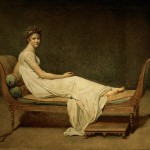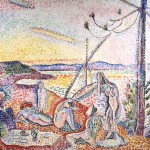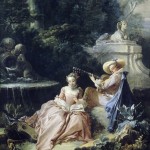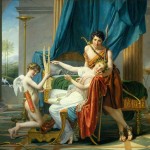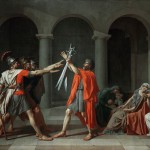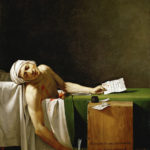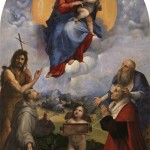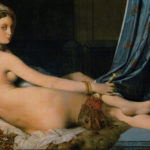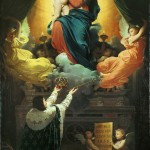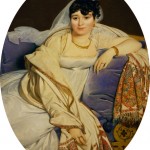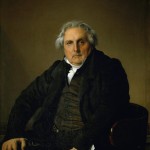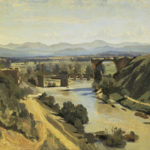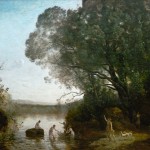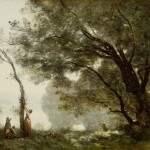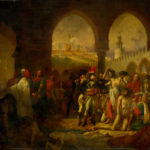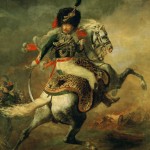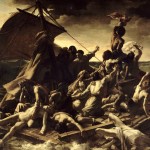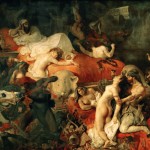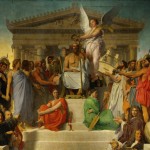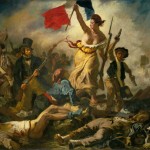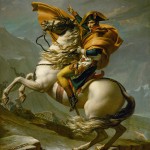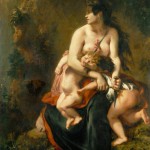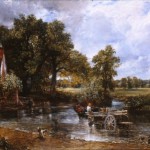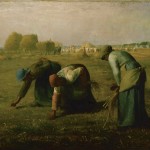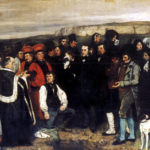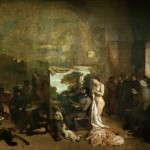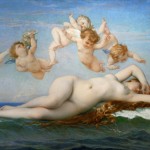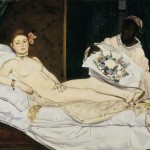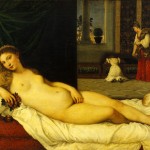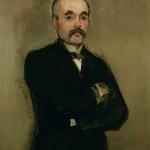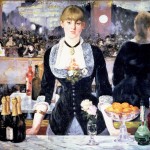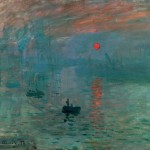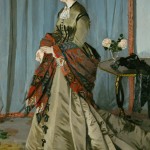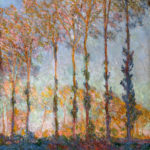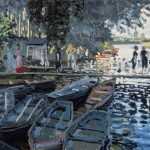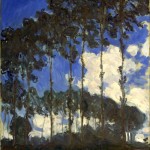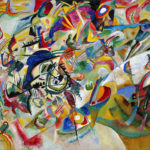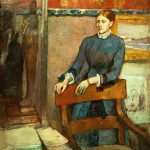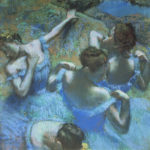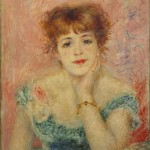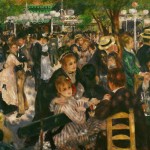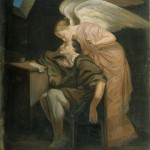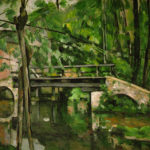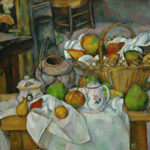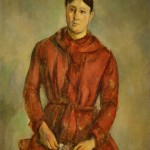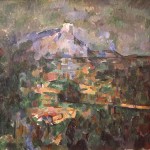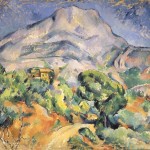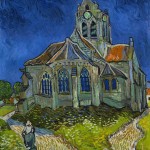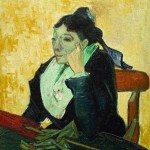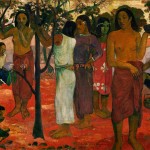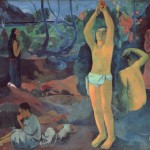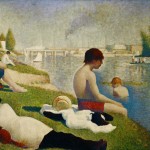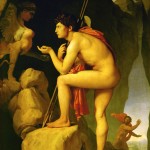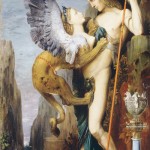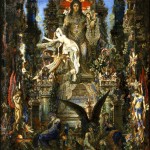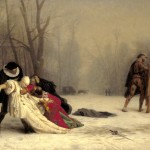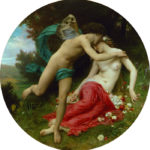In 1800, the French were enchanted to make the acquaintance of the elegantly reclining, fashionably attired Madame Recamier, 1800 (fig. 1), as portrayed by Jacques-Louis David. A century later, in 1904, they were accosted by the splotchy, psychedelic figures in Matisse’s Luxe, calme, et volupté (Luxury, calm, and pleasure) (fig. 2). Such a radical change in style is startling, particularly given the glacial pace of artistic development over previous centuries. The Renaissance lasted about 200 years, the Baroque about a century. But in 19th-century France, style succeeded style within decades. Neoclassicism, introduced to France by David, was dominant for only forty years or so. Romanticism ruled for about twenty-five, Naturalism for about twenty. Impressionism (as an organized movement) and Pointillism survived barely a decade each.
What caused this rapid succession of styles in the 19th century, and what caused the styles to veer in the direction they did? Artistic trends are not the result of some ineffable, collective esthetic consciousness working its will; they are simply the styles that the majority of artists choose to embrace. Ultimately, the choices of individual artists shape a period’s styles. Most artists (like most butchers, bakers, and economics professors) accept without question the ideas popular among their contemporaries. We must seek the explanation for 19th-century changes in art in the cultural and philosophical context of that period.
Let us take a moment, then, to survey the 19th century, a period of astounding advances in human knowledge and enjoyment. To a thorough understanding of gross anatomy and physiology gleaned during the Enlightenment, scientists such as Virchow, Bell, Pasteur, and Lister added knowledge of cellular structure and activity, the brain and nervous system, the disease-causing role of bacteria, and the anesthetic effects of chloroform and ether. As a result of these and other advances in medicine and public health, the average life expectancy soared from about 30 years in 1800 to about 50 in 1900.
Not only were people healthier and longer-lived, they had more leisure time and more means to enjoy life. People of middle-class means and average education avidly read Hugo, Dumas, Dostoevsky, Dickens, and other novelists; they were thrilled by the operas of Verdi and Wagner; they listened spellbound to music by Beethoven, Chopin, and Tchaikovsky; they gazed at Old Masters in newly established art museums; they sauntered through grandly landscaped parks, and journeyed in comfort by rail or steamship.
New knowledge, new ideas, and new works of art circulated much more rapidly due to the explosion of communication and transportation technology during the Industrial Revolution. In 1800, news traveled only as fast as the sailboat or horse that relayed it, routinely taking weeks to cross an ocean or a continent. Books were set in type by hand and printed one laborious page at a time on handmade paper. By 1900, information could be transmitted almost instantaneously by telegraph or telephone, and inexpensive books and periodicals were printed from huge rolls of machine-made paper on electric-powered rotary presses with machine-cast type.
This increase in the speed at which information could be transmitted or reproduced was certainly a factor in the rapid changes in art: Reproductions and reviews of new artworks could travel more rapidly than ever before; thus, new styles could be more readily embraced or rejected. But this does not explain what caused artists to move from producing and appreciating the likes of the Madame Recamier to producing and appreciating the likes of the Luxe, calme, et volupté. The explanation for that lies not in the realm of technology, but in the realm of ideas.
Enlightenment Ideas and the Philosophy of Kant
The magnificent scientific and technological achievements of the 19th century were based on a few fundamental premises: that reality exists independent of man’s mind; that man can know reality by means of reason, observation, and logic; and that he can act on his knowledge to improve his world and enjoy his life. Unfortunately, while these ideas were widely held to be true, neither the men of the Enlightenment nor their successors could philosophically defend them. In particular, they could not defend the idea that what man knows by means of reason is, in fact, reality. This left them vulnerable to a philosophy that brought dire practical consequences: the philosophy of Immanuel Kant (1724–1804).
In the late 18th century, Kant devised a philosophy based on the premise that man’s mind is invalid, that his senses distort the data they encounter and thus deliver not knowledge of reality, but knowledge of a pseudo-reality—a “world of appearances” that Kant called the “phenomenal world.” Reality as it really is, the world of “things in themselves” (Kant’s “noumenal world”) is out of man’s rational reach and can be known (if at all) only by non-rational means—that is, by intuition, faith, or feelings.
Over the course of the 19th century, Kant’s ideas were increasingly embraced by philosophers, accepted by intellectuals, and absorbed into mainstream culture throughout Europe and the United States. They afflicted everything from science to politics to education to art—including our particular concern: painting. As we will see, respect for reason among painters and art critics declines and then disappears in the course of the century. It is no coincidence that both Karl Marx and Henri Matisse came to prominence during the 19th century; the works of both were born of Kantian premises.
We will resume our discussion of the causal connection between Kant’s philosophy and modern art following our survey of 19th-century French painting, which will provide much evidence in support of the connection.
Writings of 19th-Century French Painters
Most of the influential developments in art over the course of the 19th century either originated or were thoroughly explored in France. To discover the ideas behind these developments, we will examine the paintings and writings of eighteen artists who meet two criteria. First, each exercised a major influence on contemporary or subsequent artists. Second, some of the artists’ comments on the nature of art were recorded and passed down to us. We will also consider the writings of three prominent art critics (Charles Baudelaire, John Ruskin, Emile Zola) who were closely associated with specific artists and movements.
None of these artists or critics presented an organized theory of esthetics. Our focus will therefore be on four important issues that recur in their writings.
1. Is formal training for an artist necessary or even useful? Will learning techniques, such as linear perspective and anatomy, benefit an artist, or obliterate his originality?
2. What role do reason and emotions play in the creation of art? Does art depend on rational thought, or on feeling? Must an artist choose one or the other?
3. What is the relationship between style and subject? Which is more important: the “how” or the “what” of the artwork, the method or the content?
4. Who is competent to judge art: viewers, other artists, professional art critics, or a combination of the above?
Although all these issues are directly related to art and its interpretation, they also presuppose philosophical ideas about how man gains knowledge of reality. An artist’s or critic’s position on this fundamental issue will govern his entire approach to the creation or evaluation of art.
The elephant in the room—always present but seldom discussed—is the question, “What is art?” Anyone commenting on the four issues above has at least an implicit idea of what art is, yet only a few of our artists discuss it. In the rare cases when such definitions are offered, we will, of course, consider them.
When reading artists’ writings, we must remember (indeed, it would be difficult to forget) that few artists could spare the time to become philosophers, scholars, or intellectuals. Many of their comments are casual references from correspondence, in which they understandably did not bother to define their terms or state their ideas with rigorous precision. Since knowing an artist’s background often clarifies such statements, we will look at each artist’s life and work before reading what he has to say about art. The context often elucidates a pithy but perplexing phrase, so most of the quotes included are of substantial length.
Attempting to translate 19th-century artists’ comments into modern esthetic terminology would risk misrepresenting their views. Moreover, for our purposes, such translation is unnecessary since the information we seek is straightforward. Does an artist approve of education? Does he consider reason (thought, conscious mental effort) more important in creating a work of art than feelings (emotions, subconscious urges, whims)? Does he believe an artist ought to focus more on what he is painting, or how he is painting it? Whom does he consider qualified to judge art, and why? The answers to such questions are usually obvious, if an artist’s thoughts on them are recorded at all. Thus, despite confusing terminology and imprecise formulations, we will see clear trends in each of our four issues over the course of the century.
Prelude: The Academy and the Salon
In 1648, after decades of divisive religious wars, Louis XIV of France (ruled 1643–1715) resolved to promote a sense of national identity and unity by establishing the Royal Academy of Painting and Sculpture. To become a member of the Academy was an honor for any artist and a boost for his career. Members tended to be conservative rather than avant-garde, since being chosen required the approval of Academy members who had already been elected—sometimes decades ago.
By the late 17th century, Academy members controlled commissions in public art and teaching in fine-arts academies throughout France, including the most prestigious one, located in Paris. The Paris school still exists as the Ecole des Beaux-Arts, the name it was given after the French Revolution.
Members of the Academy and their pupils were “encouraged” by their sponsor, the government, to produce didactic paintings and sculptures that would teach the French people to be patriotic and pious. The subjects of choice were moralizing narratives from Greek, Roman, and French history. For a century and a half, the most lucrative commissions in France went to painters who produced such government-approved “history paintings.” Portraits, landscapes, and still-lifes were considered mundane, unprestigious ways to supplement income between history paintings.
Academy members chose the works that were displayed at the annual Paris exhibition known as the Salon. Well into the 19th century, having paintings displayed at the two-month Salon was the most effective—and virtually the only—way for an artist to sell his work. The royal family, government officials, nobles, and wealthy bourgeoisie flocked to the Salon to view, discuss, and occasionally purchase the latest in French art. By the 1840s, attendance had reached a million or so, and writing critiques of the works on display was a thriving business. Until the 1880s, having work consistently accepted for the Salon was the hallmark of an artist’s success, but the conservative Academy could, and did, block admission to the Salon of the work of artists whose subjects or styles they disapproved. This was the state of the French art world when the first Neoclassical artist appeared on the scene.
Neoclassicism
Jacques-Louis David (1748–1825)
Typical of mid-18th-century art is Boucher’s Music Lesson, 1749 (fig. 3), with its charming, elegant, aristocratic young people acting out stories of love and gallantry amid lush landscapes, the whole painted in pastel colors and shades of deep green. In the world of Boucher and fellow Rococo artists such as Fragonard and Watteau, what mattered were love, gaiety, elegance, wit, and grace. Jacques-Louis David trained with Fragonard, and his early works such as Sappho and Phaon, 1770s (fig. 4), are thoroughly Rococo in subject and style.
But while the Rococo was flourishing in France, another movement was rising in Italy—a reversion to the ancient Greeks and Romans, a new classicism. By this time, imitating the ancients was much easier than it had been for Renaissance artists. The quest for knowledge of Enlightenment scholars led to widely published archeological excavations in Italy. Yet a thousand or so years of exhumed classical antiquity supplied artists with choices as bewilderingly varied as the elephant presented to the blind men. An artist might adopt the subjects of Greek myth or Roman history. He might adopt the calm and dignity of Early Classical Greek sculpture, the idealized bodies of High Classical sculpture, the emotions and dramatic movement of Hellenistic Greek sculpture, or the naturalistic portraits of late Hellenistic or Roman sculpture. He might latch onto tunics and togas, symmetry and balance, or stark whiteness.
In 1755, Johann Joachim Winckelmann, the most renowned archeologist of the 18th century, advocated a return to the “noble simplicity and quiet grandeur” of the ancients.1 At nearly the same time, Diderot (1713–84)—the guiding force behind the Encyclopedia, that epitome of the Enlightenment’s systematization of knowledge—declared that any honest man who took up pen, brush, or chisel has a didactic purpose: ”to render virtue lovable and vice odious.”2
In 1784, David rejected his Rococo roots with the Oath of the Horatii (fig. 5), the image of stoic, patriotic Romans setting out to war that marks the beginning of Neoclassicism in France. David’s new style harked back to the severe and dignified mood of the Roman Republic, with noble and heroic figures determined to die if necessary while defending their principles. To emphasize the Republican setting, David incorporated archeologically accurate details of costume, furniture, and architecture. His own contribution (seldom evident in other Neoclassicists) was a sense for drama and emotional impact. In this work, he has accomplished that with the contrast between the upright, stoic men and the huddle of wailing women.
The Oath of the Horatii illustrates that David had dramatically changed not only his subjects but his style. He cut off the depth with a wall or backdrop. He eliminated extraneous and distracting elements. David’s compositions were balanced, the focus obvious, the figures and background cropped at carefully calculated points. Rather than Rococo pastels and deep greens, David now favored somber colors: cream, dull orange, and slate blue against brown. All the lines and contours were sharp and clear. Individual brushstrokes were so meticulously applied as to be imperceptible.
Although he consciously imitated the ancients, David was no second-rate copyist. His distinctive style was evident even when his subject was not classical. In the Death of Marat, 1793 (fig. 6), painted to honor one of the French Revolution’s most ruthless leaders, he used the same techniques: somber colors, shallow depth, crisp lines and details.
Note that David’s meticulous rendering did not mean he reproduced every detail he saw. Marat habitually worked in his bath because he suffered from a repulsive and painful skin disease. David, who had visited Marat at home the day before Marat was stabbed, certainly knew of the skin condition. In this portrait, David chose to eliminate it, transforming Marat into a handsome, heroic martyr. Although David included many precise details, he was, in fact, highly selective.
David on Training
David had little to say about the education of artists, but his own rigorous academic training shows in his meticulous depiction of people and objects, and in his command of perspective and other technical skills. In time, he established a successful atelier where he trained many young artists. Presumably, then, he considered such training beneficial.
David on Reason, Emotions, and Art
One of David’s most famous pronouncements relates to the function of art. In 1793, the year of the Reign of Terror, he told his colleagues at the Revolutionary Convention:
Your Committee [i.e., the Committee that David himself led] has, therefore, considered the arts in the light of all those factors by which they should help to spread the progress of the human spirit, and to propagate and transmit to posterity the striking examples of the efforts of a tremendous people who, guided by reason and philosophy, are bringing back to earth the reign of liberty, equality, and law. The arts must therefore contribute forcefully to the education of the public.3
David’s idea of which virtues the arts should teach are (literally) revolutionary, but his idea that art’s primary function is didactic goes back to ancient times. Plato proposed legal restrictions on artists, so that their works would show only proper virtues to citizens of his Republic. Roman Emperors erected monuments to remind their subjects of the glories of the Empire. In the Middle Ages, the clergy permitted art because images could educate illiterate laymen about Christian stories and doctrine. Louis XIV in the 17th century encouraged art that he thought would teach his subjects to be pious and patriotic. To view art as didactic is incorrect, but not at all novel. (We will consider the proper function of art later.)
For our present purpose, the relevant point about using art as a didactic tool is the assumption that underlies such use. If art is meant to teach, then it has to be created by a process of thought and for a specific purpose. If a viewer gains knowledge from it (rather than simply experiencing an emotion), then the viewer must use his mind as well. It follows that, for David, reason has a very large part both in creating and interpreting art.
Elsewhere, David states the artist’s need for reason more explicitly:
The artist, therefore, must have studied all the qualities of humankind; he must have a great knowledge of nature; he must, in a word, be a philosophe. Socrates, able sculptor; Jean-Jacques [Rousseau], good musician; the immortal Poussin, tracing on a canvas the most sublime lessons of philosophy, are witnesses enough to prove that genius must have no other guide than the torch of reason.4
Philosophe in the 18th century had a very specific meaning: It referred to French Enlightenment intellectuals who believed that the natural world could be known by the use of reason. David was asserting that an artist needed to be (in modern terms) both an abstract thinker and a scientist.
David on Style and Subject
David noted in 1796:
The Greeks had no scruples about copying a composition, a gesture, a type that had already been accepted and used. They put all their attention and all their art on perfecting an idea that had been already conceived. They thought, and they were right, that in the arts the way in which an idea is rendered, and the manner in which it is expressed, is much more important than the idea itself.5
Does this mean that David considered style more important than subject? Based on his idea that art’s function is primarily didactic, he clearly did not mean a painter should ignore content and think only about line, color, and so forth. Most likely he means that originality in subject is not necessary—that it is acceptable to paint (as David often did) a subject from Greek, Roman, or French history, as long as one presents one’s own interpretation or theme.
David’s ambiguity on this matter illustrates a major weakness in 19th-century writing on art. No 19th-century artist or critic began his writings on esthetics by defining such basics as subject, style, or theme, much less the broader abstraction “art,” hence none could discuss these matters with rigorous clarity. Early in the 19th century, the lack of definitions was not a major issue. Artists had similar training and shared many premises, even if they could not articulate them. A century later, however, avant-garde artists no longer shared those premises. At that point, as we will see, the fact that traditional artists could not state exactly what they stood for crippled their ability to defend themselves.
David on Judging Art
David asserted that rather than being sold immediately to the wealthy, art should be submitted to the judgment of the public. Artists would receive an income from the exhibition’s admissions fees, and the public’s taste would be improved.6 He also argued that artists were not necessarily the best judges of art:
Your Committee has decided that, during a period when art, like virtue, must be reborn, to leave the judgment of the productions of genius to artists alone would be to leave them in the rut of habit, in which they crawled before the despotism they flattered. It belongs to those stout souls to whom the study of nature has lent a feeling for truth and grandeur to give a new impulse to the arts and bring them back to the principles of true beauty. Thus he who is gifted with a fine sensibility, though without culture, and the philosopher, the poet, and scholar, each in those different things which make up the art of judging the artist, pupil of nature, are the judges most capable of representing the tastes and insights of entire people in the task of awarding Republican artists with the palms of glory.7
Final Words on David
Although David was a prominent political figure during the French Revolution, he quickly accepted Napoleon’s rule. In the thirty-two-foot wide Coronation of Napoleon, 1805–07, David faithfully recorded the extravagant costumes and rituals favored by Napoleon. After Napoleon was sent to exile on St. Helena in 1815, David retreated into self-imposed exile in Brussels, where he died a decade later.
David was a first-rate and original artist in both subject and style. Unfortunately, most of his students and followers produced lifeless, insipid copies of classical art and of David’s paintings. Only one of them became a major force in French Neoclassical painting.
Jean-Auguste-Dominique Ingres (1780–1867)
Ingres was the unlikely figure who shouldered the banner of Neoclassicism after David’s exile. Following a few years’ study with David in the 1790s, he struck out on his own, producing distinctive but decidedly non-classical works. Although Grande Odalisque, 1814 (fig. 8), has David’s extreme clarity and precision, its subject is radically different: an undulating female with a contorted pose and bizarre proportions (e.g., three extra vertebrae elongate her spine). Front lighting emphasizes her sinuous outline. The colors are neither Rococo pastels nor sober browns, but pastels with an acidic tint. None of these characteristics was adopted from David or from Greek and Roman art—they were unique to Ingres.
Ingres became popular and influential in France only after he drastically revised this youthful style. The change is marked by the Vow of Louis XIII, 1824 (fig. 9), which illustrates a 1626 episode in which King Louis XIII dedicated France to the Virgin Mary. The Vow displays Ingres’s characteristically meticulous attention to detail and texture, but the Virgin Mary bears no visible kinship to the Grand Odalisque. Instead, her conventional proportions and colors recall High Renaissance works such as Raphael’s Madonna di Foligno, ca. 1512 (fig. 7).
After the 1824 Salon exhibition, Ingres (just returned from an eighteen-year sojourn in Italy) was welcomed as the leader of the French Neoclassicists. Although he continued to do conventional history paintings, he was also the most sought-after society painter of the day. Works such as Madame Rivière, 1805 (fig. 10), and Monsieur Bertin, 1832 (fig. 11), portray sitters who were elegant, wealthy, confident, and content. Echoes of Ingres’s early work still appear, especially in the sinuous curves and outlines, the sophisticated color combinations of women’s clothing, and the meticulous finish. The brushstrokes are so fine that the work almost seems painted in enamel rather than in oil paint. Ingres’s career lasted well into the 1860s.
Ingres on Training
Like David, Ingres wrote little on art. Also like David, he was a respected teacher who always had numerous students, so we can assume he believed in the value of a rigorous education in drawing, color, perspective, and so forth. He also firmly believed in studying the works of great artists:
What do those so-called artists mean when they preach the discovery of the “new”? Is there anything new? Everything has been done, everything has been discovered. Our task is not to invent but to continue, and we have enough to do if, following the examples of the masters, we utilize those innumerable types which nature constantly offers to us, if we interpret them with wholehearted sincerity and ennoble them through that pure and firm style without which no work has beauty. What an absurdity it is to believe that the natural disposition and faculties can be compromised by study—by the imitation, even—of the classic works!8
Ingres did not mean that artists should slavishly imitate the ancients, any more than they should slavishly copy models in the studio. Copying was a way to train the eye: “One must always copy nature, and learn to see well. That’s why one studies the ancients and the Old Masters, not to imitate them, but, I repeat, to learn to see.”9
Ingres on Reason, Emotions, and Art
Ingres emphasized the role of thought in the creation of art. In 1813 he noted:
When one knows one’s craft well, when one has learned well how to imitate nature, the chief consideration for a good painter is to think out the whole of his picture, to have it in his head as a whole, so to speak, so that he may then execute it with warmth and as if the entire thing were done at the same time.10
Painting, then, involves thought: A good painter plans the work out in his head before he touches a brush to canvas.
Ingres also stated:
Anti-classic art, if one may even call it an art, is nothing but an art of the lazy. It is the doctrine of those who want to produce without having worked, who want to know without having learned; it is an art as lacking in faith as in discipline, wandering blindly because of its having no light in the darkness, and demanding that mere chance lead it through places where one can advance only by means of courage, experience and reflection.11
Ingres on Judging Art
Ingres wrote:
The more sublime efforts of art have no effect at all upon uncultivated minds. Fine and delicate taste is the fruit of education and experience. All that we receive at birth is the faculty for creating such taste in ourselves and for cultivating it. . . . It is up to this point, and no further, that one may say that taste is natural to us.12
For Ingres, the ability to judge art is something one must work to acquire by continually studying art. It requires mental effort and education.
In sum, Ingres believed that learning, creating, and judging art all require significant mental effort.
Jean-Baptiste Camille Corot (1796–1875)
The third and final Neoclassical painter we will consider is Corot, who is roughly contemporary with Ingres. Corot’s training included study under a pupil of David. Like Ingres, he soon found that history painting was not his preferred subject. In 1826, at age thirty, he confessed, “I have only one aim in life, which I want to pursue steadfastly; to make landscapes.”13
Probably because history painting was still considered the best painting, Corot’s landscapes always have a few figures or some sign of human presence and activity. The Bridge at Narni, 1826 (fig. 12), painted a few years after Ingres’s Vow of Louis XIII (fig. 9), is a well-ordered landscape dominated by a bridge and roads. In Diana Bathing, 1855 (fig. 13), the landscape fills the painting, but the small figures near the center refer to Greek myth.
Corot’s early style resembles those of David and Ingres, in that he renders details and lines with great precision and without visible brushstrokes. In contrast to them, he prefers bright, cheerful hues (green, yellow, blue), and he shows strong contrasts of sunlight and shadow. More than earlier French artists, Corot loved to sketch in the open air. Back in the studio, he worked these “notes” into compositions with figures.
Thirty-seven years after Bridge at Narni, Corot painted Memory (Souvenir) of Mortefontaine, 1864 (fig. 14). Figures still dot the landscape, although now they are contemporary and anonymous rather than participants in a narrative, and the landscape no longer represents a distinctly identifiable place. Corot’s style has also changed radically. Many of his late landscapes lie in perpetual silvery brown twilight, details blurring into darkness. Look, for instance, at the soft smears that represent leaves. This late style was particularly easy to imitate, which (added to the fact that Corot often signed the work of his students) soon made him a favorite target of forgers. One early biographer said wryly that Corot painted 3,000 paintings, of which 10,000 were in the United States.14
In Corot’s early paintings, the world is a bright and cheerful place. In his later works, it is much gloomier. But it remains a place where man belongs: Corot never paints landscapes bereft of human beings or their effects.
Corot on Reason, Emotions, and Art
Around 1828, about the same time that he painted the Bridge at Narni (fig. 12), Corot wrote:
Drapery and, in general, all things that are fairly regular need much exactness. I see, too, how meticulously one must follow nature, and not be satisfied with a hasty sketch. How often, looking at my drawings, have I been sorry that I hadn’t had the energy to spend half an hour more on them. . . . Nothing should be left to indecision.15
Such conscientious observation and recording implies that painting requires rational effort. But twenty years later, Corot had changed his mind:
Be guided by feeling alone. We are only simple mortals, subject to error; so listen to the advice of others, but follow only what you understand and can unite in your own feeling. Be firm, be meek, but follow your own convictions. It is better to be nothing than an echo of other painters.16
Does he simply mean, “To thine own self be true”? Apparently not, for the passage continues:
While I strive for a conscientious imitation, I yet never for an instant lose the emotion that has taken hold of me. Reality is one part of art; feeling completes it. Before any site and any object, abandon yourself to your first impression. If you have really been touched, you will convey to others the sincerity of your emotion.17
Years later Corot told a friend that he had never been taught, but had faced nature and found his own style: “Yes, I put white in all my colors, but I swear I do not do it on principle. It is my instinct, and I obey my instinct.”18
Ingres said one must think out the whole composition of a painting inside one’s head. Corot said thought (“conscientious imitation”) and feeling are equally important and equally necessary, and introduced the term “instinct” for the way he applied color. This is the first time in this article that we have seen emotion mentioned as a requirement for a painter, but as we will soon see, Romantic painters had been advocating it for quite some time before these passages from Corot were recorded.
Final Words on Corot
Corot was roughly contemporary with Ingres, but he began with a sharp, clear style and ended with one that was blurry and fuzzy. Such changes are common. An artist rarely signs on to a particular movement and resolutely cleaves to it for decades: witness David and Ingres, among many others. The artist’s ideas and values may change, or he may simply decide to embrace a style that seems more saleable. Corot began as a Neoclassicist but ended his career with a style that influenced the Impressionists, whose first exhibition was in 1874—only ten years after Memory (Souvenir) of Mortefontaine (fig. 14).
Summary of Neoclassicism
Despite wide-ranging differences in subject—from Napoleon to harem girls to Italian landscapes—the Neoclassical painters we have looked at share several important characteristics. Their choice of subjects usually reflects what artists had for centuries believed to be the function of art: to educate men by showing the good and the beautiful. The figures are grand and heroic. The landscapes offer reminders of human achievements. Their world is an exciting, dramatic place, where heroic and dramatic events are possible. The Neoclassicists also have a distinctive style for showing this world: precise lines, meticulous details, and balanced compositions.
The French Neoclassical movement peaked from the 1780s to the 1820s. After that, it was replaced on the cutting edge of art by Romanticism. Neoclassical style and subjects did not, however, disappear. David (d. 1825), Ingres (d. 1867), and Corot (d. 1875) all had numerous students and followers. Ingres was particularly influential: For decades, he ran a successful atelier where he taught aspiring painters his views and methods. Unfortunately, most of his students lacked the passion and innovation of their teacher. Imitating the ancients and other Neoclassical artists often resulted in static, boring paintings. The Romantic movement was, in part, a reaction against such bland works.
Before we turn to the Romantics, let us briefly review the Neoclassicists’ responses to the four issues that we are following regarding art and philosophy.
Is training necessary in order to be a good artist? David said an artist should be a philosophe, a combination of abstract thinker and scientist. Ingres advised careful study of classic works. David, Ingres, and Corot were all academically trained, and all ran highly successful ateliers for aspiring artists. Their attitude toward learning clearly reflects the Enlightenment assumption that man can know reality through the senses and logical thought, and can act to improve himself and his world.
What role does reason play in the creation of art? David said, “The guide of genius is the torch of reason.” Ingres said good art is the product of hard work and education. The young Corot said art requires close study, but by the 1850s, he considered feelings and instinct as important as rational thought. On a broader scale, David and Ingres assumed reason was involved in art because they saw art’s purpose as didactic, and both teaching and learning involve disciplined mental effort. This reflects Enlightenment ideas on the importance of rational thought.
What is the relationship between style and subject? David said that style is more important than subject, but he seems to have meant that it is acceptable to use well-known subjects, so long as one interprets them for oneself. Ingres apparently concurred when he said that artists did not need to seek out the new: “Our task is not to invent but to continue.”
Who should judge art? David thought the people should judge art, since artists themselves were not always competent to do so. Ingres said that taste is based on education and experience, which implies that esthetic judgment requires observation and rational thought. Ingres’s attitude, in particular, reflects the Enlightenment assumption that reality is knowable through sense perception combined with mental effort.
Romanticism
We now backtrack from Ingres, Corot, and their mid-19th-century followers to the 1810s, when Romantic painters began to appear in France. Scholars agree that Romanticism’s origins reach back at least to Edmund Burke’s 1756 Inquiry into the Origins of the Sublime. But what exactly was “Romanticism”? No artist at the time nor any scholar since has been able to define it. By the mid-1820s, about 150 different definitions had been suggested, none of which gained general acceptance. Romanticism’s premises and implications differed too substantially from one country to another, one decade to another, and particularly from one discipline to another.19
In philosophy, German Romantics such as Fichte (1762–1814), Schelling (1775–1886), and Schopenhauer (1788–1860) advocated outright mysticism. “The whole body is nothing but objectified will, i.e., will become idea.”20
In literature, authors such as Friedrich Schiller (1759–1805), Victor Hugo (1802–1885), Fyodor Dostoevsky (1821–1881), and Edmond Rostand (1868–1918) stressed the individual and his emotions.21 Over a century later Ayn Rand pointed out that a man’s emotions depend on his values, and his values depend on what he chooses (consciously or unconsciously) as his standard.22 Hence, in the most fundamental sense, Romanticism is the school of literature that shows man with free will, and its most distinctive characteristic is a sequence of events caused by the choices of the characters—a plot.23 But this connection between emotions, values, and volition was unknown to 19th-century artists and intellectuals.
In the visual arts, Romanticism was largely confined to painting. Beginning with Giovanni Battista Piranesi (1720–1778), Henry Fuseli (1741–1825), and Francisco de Goya (1746–1828), artists rebelled against the “noble simplicity and quiet grandeur” that Winckelmann had advocated, and which, in the form of Neoclassicism, had swept through Europe during the late 18th century. Romantic painters focused on subjects calculated to arouse strong passions. The passions could be as positive as love or as negative as terror: The important thing was to make the viewer feel something.
Baron Antoine-Jean Gros (1771–1835)
Gros did so many paintings for Napoleon that he was known as Napoleon’s propagandist, although his imposing canvases also made him popular with the Bourbon kings after Napoleon’s defeat. Napoleon in the Pesthouse at Jaffa, 1804, a huge 18 x 23 feet (fig. 15), is an early example of French Romanticism, illustrating not only the Romantics’ striving to evoke emotions but several other features that became characteristic of the movement. First, Gros depicts a contemporary event rather than one from Greek or Roman history. Here, Napoleon visits soldiers stricken with the bubonic plague during his 1799 campaign in Palestine. Second, although Gros portrays Napoleon as a hero, he makes the men surrounding Napoleon of lesser stature. Most are anonymous; a few are dying in agony. In David’s early Neoclassical paintings, by contrast, men tended to be equal in heroism and dignity. Third, Gros portrays exotic people and places. Napoleon’s 1798–99 expedition to Egypt and the Near East ignited a passion for the outlandish and extraordinary in Gros and other French painters. The depiction of contemporary events, ordinary men, and exotic settings all became typical of French Romanticism.
Despite these very non-Neoclassical characteristics, Gros still shows signs of David’s influence. Especially noticeable are the use of sharp details and sober colors, such as dark red and deep brown. The two painters differ radically, however, in the way they compose pictures. David’s figures are often arranged parallel to the picture plane, with a strong focal point that draws the viewer’s attention. Gros favors diagonals that pull the viewer’s eye toward the background, and his compositions verge on the chaotic: Our eyes jump from one spot to another.
Gros is the exception to our rule of studying only those influential artists who left comments on art. A student of David who became a Romantic, he is included, despite the lack of surviving writings, because he vividly reminds us that the creation and adoption of artistic styles are not mindless, evolutionary, or collectivist. Gros could have persisted with classical subjects and the calm nobility of his teacher, David. But an artist’s style always depends on the choices of that artist, and Gros’s choices soon led him to create paintings quite different from David’s in style and subject.
Théodore Géricault (1791–1824)
Gros showed a heroic Napoleon surrounded by ordinary men. Géricault, his contemporary, preferred anonymous modern figures in dramatic situations, as in An Officer of the Imperial Horse Guards, 1814 (fig. 16). Also characteristic of Géricault’s style is violent movement: His men and animals leap and writhe. He has a predilection for gloomy colors and for fire, smoke, and dark shadows. His brushstrokes are noticeably larger and looser than those of David, Ingres, or Corot: Look, for example, at those on the horse’s head in Officer, which suggest the animal’s energy and motion.
Visible brushstrokes are not always to be disparaged. A painter might, for instance, decide to do larger, less meticulous brushstrokes on hair or clothing, in order to focus the viewer’s attention on a face: We tend to look most closely where there is most detail. An artist might use such brushstrokes to suggest rapid movement or a dreamy atmosphere. Whether meticulous or loose brushstrokes are appropriate depends on the context of the painting. We will see a definite trend in the type of brushstrokes favored by painters across the span of the 19th century.
Géricault’s breakthrough painting was the twenty-three-foot wide Raft of the Medusa, 1819 (fig. 17), in which he depicted a recent event that had outraged his compatriots. Like Gros’s painting of Napoleon visiting plague victims, this work was calculated to raise a strong emotion in the viewer. This time the emotion was a combination of horror and pity.
In 1816, the French frigate Medusa was wrecked off the west coast of Africa. The captain, officers, and about 250 others piled into six lifeboats, promising to tow ashore a makeshift raft with another 150 passengers. But the slow-moving raft was soon cut loose, and its desperate passengers resorted to cannibalism—possibly murder. When rescuers finally arrived, they found only ten survivors. Since the Medusa’s inexperienced captain had obtained his post through nepotism, the wreck was quickly transformed into a political scandal.24
After nearly three centuries of paintings that glorified France’s history and rulers, Géricault’s Raft of the Medusa was a stunning reversal: It was the first painting to imply that the French government could be stupid or careless, and it marks the beginning of a shift from art that praised rulers and government to art that showed them with warts and all, or even warts only. Yet the Raft†was awarded a gold medal in the Salon of 1819, was purchased by the Louvre for the French national collection in 1824, and by 1830 was considered a masterpiece.
How does Géricault keep our eyes moving around the gruesome drama shown on this huge canvas? Instead of lining up his figures parallel with the front edge of the painting (as David did in Oath of the Horatii, fig. 5), Géricault arranges the figures to recede diagonally into the picture space, drawing our eye with them. Using somber colors and eerie light, he evokes a dismal mood. Notice especially the range of strong emotions Géricault depicts, from grief to despair to agony, and even (in the flag-waving figure at the top of the pyramid) hysterical hope. The dark colors, restless movement, and highly charged emotions are all characteristic of Géricault in particular as well as Romantic painting in general.
Géricault on Training
One of Géricault’s most oft-quoted statements, probably written in the early 1820s, is this:
Supposing that all the young people admitted to our schools were endowed with all the qualities needed to make a painter, is not it dangerous to have them study together for years, copying the same models and treading approximately the same path? After that, how can one hope to have them still keep any originality? Haven’t they in spite of themselves exchanged any particular qualities they may have had, and sunk the individual manner of conceiving nature’s beauties that each one of them possessed in a single, uniform style? The nuances that can survive this sort of confusion are imperceptible; and each year we see with disgust ten or twelve compositions, carried out in about the same way, painted from one end to the other with a disheartening perfection, and showing no trace of originality.25
At first glance, Géricault appears to disparage all education, but in fact, he was only attacking education in France’s state-run academies, where instruction tended to become fossilized. Such criticism had been put forward since the late 18th century.26 In some respects, the criticism was valid, and we will hear other artists repeat it. However, elsewhere Géricault clearly appreciated the need for education:
I have always believed that a good education must be the necessary basis for the exercise of any profession, and that it alone can give us true distinction in whatever career we may choose . . . [But] it should not be the purpose of this institution [the Academy] to create a race of painters, rather, it ought simply to provide true genius with the means for self-development.27
Géricault also advocated the study of earlier artists:
One must not be ashamed of returning to tradition; the beautiful in the arts can be achieved only by comparisons. Each school has its own character. If one could succeed in uniting all of their qualities would one not have reached perfection? But that requires incessant effort and great love.28
Clearly Géricault did not reject tradition, even though he was revolutionary in his subject matter.
Géricault on Reason, Emotions, and Art
The previous quote implies that Géricault considered both thought (mental effort) and emotion necessary to produce art. When he discussed how obstacles affect genius, however, he emphasized the emotional rather than the rational: “Everything which opposes the irresistible advance of genius irritates it, and gives it that fevered exaltation which conquers and dominates all, and which produces masterworks.”29
Eugene Delacroix (1798–1863)
When Géricault died in 1824, at the age of 33, Delacroix became the most prominent of the French Romantics. Ingres’s Apotheosis of Homer, 1827 (fig. 19), and Delacroix’s Death of Sardanapalus, 1827 (fig. 18), which appeared at the same Salon exhibition, vividly illustrate the differences between the Neoclassicists and the Romantics. Seldom were two such radically different paintings produced in the same city, within a year of each other.
The Apotheosis of Homer shows the author of the Iliad and the Odyssey as a genius to whom all ancient and modern artists pay homage. Homer and his admirers are arranged in front of a classical Greek temple, under a clear blue sky. The Death of Sardanapalus, on the other hand, shows a despot from ancient Assyria (centered in modern Iraq) who, learning he was about to be conquered, ordered his henchmen to slaughter his harem girls and his horses so no one else could enjoy them. Sardanapalus, reclining at the upper left, impassively observes a maelstrom of death and destruction.
The styles as well as the subjects of these two paintings are diametrically opposed. Ingres’s composition is balanced and symmetrical, with a strong focal point established by the temple’s pediment and by the central placement of Homer and the angel who crowns him. Delacroix’s composition has a long diagonal that moves the viewer’s eye back to Sardanapalus’s reclining figure. The rest of the scene is asymmetrical, full of chaotic movement. In the Ingres, the light pours in from the left, casting few shadows. In Delacroix, the room is dimly lit and full of shadows, making the scene even more turbulent and confusing.
The very brushstrokes are radically different. Ingres’s outlines are precise, his brushstrokes indistinguishable. Delacroix’s brushstrokes are easily visible (as were his predecessor Géricault’s), and his outlines are fuzzy or blurred. The type of brushstroke Delacroix used was clearly what he considered appropriate for this subject. In a portrait of his aunt, he depicted the facial features with precision but the lace of her headdress with a very free hand.30
For Ingres and the other Neoclassicists, the purpose of art was didactic: to depict truth and beauty, and thus teach the viewer how to be a better, more moral person. The restrained, low-key mood is appropriate for such an intellectual aim. For Delacroix and the Romantics, the purpose of art was to evoke a strong emotion—with Sardanapalus, a dozen variations on terror—and gloomy and chaotic styles were appropriate for that goal.
Evoking emotion is what Delacroix did best. In one of his most famous paintings, Liberty Leading the People, 1830 (fig. 20), Delacroix shows common people in a dramatic situation, as Géricault had done. Here, in a commemoration of one of Paris’s many rebellions against royal authority, allegorical Liberty triumphantly leads Parisians across piles of corpses and rubble. At the left, Delacroix included a self-portrait in a top hat. The boy on the right soon became the inspiration for Gavroche in Hugo’s Les Misérables. As in Death of Sardanapalus, Delacroix here favors blurred details and murky colors without much contrast of light and dark.
Soon after 1830, Delacroix switched from painting contemporary events, such as rebellion in the streets of Paris, to depicting exotic milieus (Women of Algiers, 1834) and religious subjects (Jacob Wrestling with the Angel, 1854–61). In these, Delacroix used a brighter palette, but even here his colors are murky compared to the clear hues of Ingres. Murky colors and blurry details remain characteristic of Delacroix’s style throughout his career.
Delacroix on Reason, Emotions, and Art
In 1853, Delacroix wrote:
Nature is far from being always interesting from the standpoint of effect and of ensemble. If each detail offers a perfection which I shall call inimitable, these details collectively, on the other hand, rarely present an effect equivalent to the one which results, in the work of the great artist, from the feeling for the ensemble and the composition.31
Selecting details and arranging a composition implies that conscious thought has a role in the creation of art. Delacroix’s assertion that artwork conveys a message confirms this: “Is there not a moral attached even to a fable? Who should reveal this better than the artist, who plans every part of the composition beforehand in order that the reader or beholder may unconsciously be led to understand and enjoy it.”32
But Delacroix also saw emotions as invaluable, and disparaged rational thought when painting:
I do not at all like reasonable painting. I recognize that it is necessary for my turbulent mind to be agitated, to destroy its bonds, to try out a hundred manners before arriving at the goal, the need for which torments me in everything. There is an old leavening, a pitch-black depth to satisfy. If I am not agitated like a serpent in the hands of a pythoness, I am cold. This must be recognized and be submitted to; and this is a great pleasure. Everything that I have done well has been done in this way.33
It is no wonder that Ingres, a highly cerebral painter, regarded France’s most famous Romantic as the devil incarnate. Passing Delacroix at an exhibition he growled, “I smell sulfur.”
Charles Pierre Baudelaire (1821–1867)
We now turn briefly to a man who is not an artist but an art critic—a relatively new phenomenon. During the 19th century, several factors combined to make art critics enormously influential. Due to the Industrial Revolution, the standard of living was rising, and more people could afford to purchase art. Increased wealth and productivity also led to widespread literacy and greater leisure, after centuries when most people had struggled from dawn to dusk for mere subsistence. Inventions such as the steam-powered printing press, wood engraving, photography, lithography, and inexpensive wood-pulp paper made it easier and faster to transmit ideas and images. More people than ever saw and read about the latest developments in art.
Yet there were still no accepted standards for judging art. This provided the perfect breeding ground for the emergence of professional art critics, who made it their mission to tell the public which type of art they ought to approve of. Critics’ reviews of the Paris Salon exhibitions were printed in periodicals and circulated widely in pamphlet form. Among the critics who achieved lasting fame were Baudelaire, Ruskin (see section on the Naturalists), and Zola (see section following Manet).
Baudelaire was born in 1821, about the time Romanticism burst onto the French art scene, and died in 1867, the year Ingres died. His Flowers of Evil, 1857, was arguably the century’s most influential collection of poetry. The opening lines to his readers reveal Baudelaire’s horrendous sense of life:
Stupidity, delusion, selfishness and lusttorment our bodies and possess our minds,and we sustain our affable remorsethe way a beggar nourishes his lice.
Baudelaire’s published comments praising Delacroix boosted that artist’s fame and influence. In fact, much of what is accepted as the Romantic attitude toward art was actually Baudelaire’s interpretation of Delacroix.
Regarding Delacroix’s style, Baudelaire said:
From Delacroix’s point of view, line does not exist; for no matter how thin it may be, a maddening geometer can always suppose it thick enough to contain a thousand others; and for colorists, who seek to imitate the eternal palpitations of nature, lines are never other than the intimate blending of two colors, as in the rainbow.34
Peer intently at Delacroix’s Liberty Leading the People (fig. 20) and its outlines actually seem to vibrate.
What makes Delacroix distinctive, according to Baudelaire, is not a style or subject but an emotion—a feeling, rather than a way of thinking or acting:
There remains for me to note one last quality in Delacroix to complete this analysis, the most remarkable quality of all and one that makes him the true painter of the 19th century: it is the singular and obstinate melancholy that runs through all his works, and that is expressed in his choice of subject, by the expression of his faces, through gesture, and in his kind of color.35
In his obituary of Delacroix, Baudelaire pithily summed this up: “Delacroix was passionately in love with passion, and coldly determined to seek the means of expressing it in the most visible way.”36
Remember that no one had properly defined Romanticism. This is Baudelaire’s attempt in 1846, when the movement in France was already several decades old:
Romanticism is precisely located neither in the choice of subject nor in exact truth, but in the mode of feeling. They looked for it outside themselves, and it is only to be found within. For me, romanticism is the most recent, the most up-to-date, expression of the beautiful. . . . Who says romanticism, says modern art—that is, intimacy, spirituality, color, aspiration toward the infinite, expressed by every means at the disposal of the arts.37
No one could pick a work of Romantic art out of a gallery exhibition based on this vague “definition.”
But after all, why does it matter whether we can define romantic art, or indeed art in general? Is it not enough to be able to affirm, on gut instinct, that an object is or is not a work of art? No. Without a proper definition, we do not have a firm basis for understanding, discussing, or judging art. Art could be “anything an artist produces,” or “any object of pleasing color and/or shape,” or “anything an art critic decrees to be art.” When we consider other definitions of art offered by 19th-century artists, it will begin to be obvious why works such as Matisse’s Luxe, calme, et volupté were not only accepted by 1900, but acclaimed. (We will consider the proper definition of art in the Conclusion.)
From the quote above, it is clear that in the debate over the role of reason vs. emotion in art, Baudelaire is pro-emotion. Closely related to this emphasis on emotion is the idea—shared by Baudelaire and a number of prominent contemporary critics—of “art for art’s sake,” as opposed to art that serves didactic purposes. 38 A didactic purpose requires that the artist carefully work out the details that will convey his message, and that the viewer sees the details and grasps the message. But if art exists only for its own sake, that rational element is unnecessary. The artist is free to focus only on trying to express his own emotions. Furthermore, if art exists only for its own sake, has no purpose beyond existing, there can be no standard for judging what good art is, or what is and is not art.
Summary of Romanticism
Although we have not yet heard a proper definition of Romantic painting, we have observed several of its recurring characteristics. The subjects are ordinary men in dramatic situations, exotic places, or both. The narratives are usually contemporary—few are taken from Greek or Roman history, or even French history. Man is the center of the world in these paintings, and his situation is often dramatic, sometimes heroic. But in contrast to the paintings of the Neoclassicists, he is usually suffering, struggling, sometimes dying. Although he may have grandeur and dignity, the mood is never one of unadulterated triumph or joy. Liberty Leading the People (fig. 20) does so over piles of corpses. The aim of Romantic painters was to rouse passions, but not necessarily positive ones.
The lighting tends to be gloomy or murky, the colors subdued. Compared to the Neoclassicists, Romantics’ brushstrokes are easily visible and there is less attention to texture. The Romantics also create compositions with dramatic movement via diagonal lines, avoiding symmetry and balance.
With these characteristics of subject and style in mind, you might think it would be easy to distinguish a Neoclassical painting from a Romantic one. Yet, as we saw when discussing Corot, artists do not sign on to one movement or set of rules and stay with it throughout their lives. Arch-Romantic Delacroix painted Medea Kills Her Children, 1838 (fig. 22), a subject from Greek myth—albeit a violent one. Napoleon at St. Bernard, 1801 (fig. 21) is akin to Géricault’s Officer of the Imperial Horse Guards, (fig. 16), but it was painted in 1801 by David, the first French Neoclassicist, when Géricault was only ten years old. An artist can and often does change style and subject to achieve different purposes, or as he develops his own ideas. A study of historical styles is a study of the dominant trends of a period; one should never slip into the error of assuming that any particular artist was constrained to follow the trend. Each made his own choices about style and subject.
What about the issues we have been following regarding art and philosophy? The Romantics we have considered discussed only two of them. With regard to training, Géricault said an education (including study of earlier artists) is necessary, but believed academic studies had the potential to stunt originality. With regard to the role of reason and emotion in the creation of art, Géricault and Delacroix agreed: Both considered thought necessary, but emotion even more important. Baudelaire went a step beyond that. He advocated “art for art’s sake,” rejecting the old (and incorrect) idea that art ought to be primarily didactic. Creating and grasping didactic art required rational thought; “art for art’s sake” opened the way for art that expressed whatever whim the artist might feel.
This shift, from reason to emotion as the essential faculty in the production and evaluation of art, springs from the Kantian notion that sensory observation and logic do not provide a means for knowing reality. If they do not, what is left? Some sort of feeling, whether it be called divine inspiration, intuition, or gut instinct. Over the decades that follow Baudelaire and the Romanticists, we will see the derogation of reason and the emphasis on emotion becoming more and more pronounced.
Naturalism
The Neoclassicists and Romantics vied with each other for several decades, but by the 1850s, both Ingres and Delacroix were mainstream artists. Each had a roomful of paintings on display at the 1855 Universal Exposition in Paris.
The rebels by that time were the Naturalists. Like Romanticism, Naturalism began abroad and was adopted by French painters. This time the models were British landscapes such as John Constable’s Hay Wain, 1821 (fig. 23), exhibited in Paris in 1824 to lavish praise from Delacroix and others. Constable was famous for appearing precisely to record such natural elements as foliage, light, and moisture. (Compare the trees in the Hay Wain with those in the background of Boucher’s Music Lesson, fig. 3.) The emphasis in Constable’s paintings was on nature; if men appeared at all, they were anonymous farmers and workers.
Before we look at how the French “translated” Constable, a brief note on the use of the term “Naturalism” by art historians and by Ayn Rand. Historically, Naturalist painters (sometimes called “Realists”) date to the mid-19th century. Prominent among them were Constable in England and Millet, Courbet, and the Barbizon School in France. They did not have a manifesto or a single strong leader, but they are recognizable from their preferred subjects: landscapes or hard-working farm laborers.
As opposed to the art-historical use of Naturalism, Ayn Rand uses the term primarily to describe a literary phenomenon. Among Romantic novelists, the hero is “an abstraction of man’s best and highest potentiality, applicable to and achievable by all men, in various degrees, according to their individual choices.”39 Naturalists, on the other hand,
claim that a writer must reproduce what they call “real life,” allegedly “as it is,” exercising no selectivity and no value-judgments. By “reproduce,” they mean “photograph”; by “real life,” they mean whatever given concretes they happen to observe; by “as it is,” they mean “as it is lived by the people around them.”40
The essential difference between the Naturalists and Romantics, she says, is that Romantics believe man has free will, while Naturalists do not.
Do the senses in which art historians and Ayn Rand use the term “Naturalism” overlap? In assessing a painting, it is difficult to tell whether an artist intended his subjects to be perceived as having the power of choice, but a quotation from Millet, a French Naturalist painter, does indicate a desire to show people as if they had no free will: “I want the people I represent to look as if they belonged to their station, and as if their imaginations could not conceive of their ever being anything else.”41
Let us return to the matter of the historical Naturalists. In 1863, Millet pedantically explained:
In The Sheep That Have Just Been Shorn, I have sought to express that kind of bewilderment and confusion that the sheep experience when they have just been stripped of their wool, and also the curiosity and astonishment of those which have not yet been shorn on seeing such denuded creatures rejoin the flock.42
The Neoclassicists showed dignified, courageous men in dramatic situations. The Romantics showed ordinary men in dramatic situations. The Naturalists showed ordinary men performing exhausting, mundane physical labor, and the profound emotions of . . . sheep.
Naturalist painters often include a great deal of detail in their works. In fundamental terms, however, the amount of detail is irrelevant. The difference between them and the Neoclassicists or Romantics relates to subject rather than style. Monsieur Bertin, (fig. 11), by Neoclassicist Ingres, is represented with extreme detail, from the wrinkles on his face to the reflection on the arm of the chair. What situates M. Bertin†far outside the realm of Naturalism is the fact that it shows not a nameless laborer but a man who is impatient, intelligent, aggressive: a vivid and unique character.
Jean-Francois Millet (1814–1875)
“Since I have seen nothing in my life but fields,” Millet wrote, “I try to say as best I can what I have seen and felt as I worked there.”43 In actuality, although Millet was the son of peasants, he studied painting in Paris with David’s pupil Gros, one of the earliest French Romantics. He was hardly a country bumpkin, and his subjects were consciously chosen, not determined by his upbringing.
Millet’s earliest works were conventional, charming portraits of middle-class Frenchmen. By the late 1840s, however, he had settled on a favorite subject: toiling peasants. In The Gleaners, 1857 (fig. 24), the women turn their faces away, backs bowed with fatigue—anonymous and exhausted. Although the sturdy figures stand out sharply against the fields, the details within each figure are blurred and indistinct.
Millet liked to position his figures in a somber setting, under cloudy skies or at dusk. Often he set the horizon line high in the picture, reducing the amount of sky and hence the amount of light that reached the figures.
Millet’s choice of subjects was novel, especially compared to the heroic drama of the Neoclassicists and the emotional revels of the Romantics. Half a century earlier, Jean-Baptiste Greuze (1725–1805) had depicted the lower classes, but always with a moralizing, didactic message. Millet’s works are not moralizing but nostalgic. He shows men doing obsolete jobs with old-fashioned tools, but his workers are on an epic scale—one or two usually fill a large canvas. It is as if Millet is recalling a long-past golden age when living by manual labor and the literal sweat of one’s brow was an idyllic occupation.
Millet on Reason, Emotions, and Art
Millet wrote in 1863:
It is not so much the subjects represented that create beauty, as the need one feels to represent them. And this need of itself creates the degree of power sufficient to accomplish the work. One might say that everything is beautiful, provided that it occurs at the right time and place, and that nothing can be beautiful that appears out of season.44
What assumptions underlie this statement? First, an artist’s feelings matter more than his subject or execution. Second, strong feeling will give an artist the power to produce a work of art: If you want it badly enough, you will have the ability. Third, beauty is subjective: Anything can be beautiful in the right place, at the right time. We have already seen an intimation of this turn from reason toward emotion in Delacroix, who said he had to be turbulent and agitated to do his best work.
Millet on Judging Art
Millet’s statement that everything is beautiful “at the right time and place” is our first sign of a trend toward a new way of judging art. The new standard is: There are no standards; everything is contextual and subjective. What you consider beautiful I might find appalling, and there is no way to choose objectively between our evaluations.
Gustave Courbet (1819–1877)
Millet changed the subject matter of French art. Courbet went further, attacking what had been the esthetic norms. Like Millet, he painted hard-working laborers—but laborers of a quite distinct sort. Writing about The Stone-Breakers, 1851 (destroyed), Courbet described one man as wearing pants so filthy they could stand up by themselves, and the other as having scurvy and wearing shoes with holes in them.45 By comparison, Millet’s peasants seem heroically clean and healthy. Courbet also offended traditionalists with his paintings of nudes, which depicted, in garish colors, fat women and toil-worn men.
Courbet is most famous for paintings such as Burial at Ornans, 1849-50 (fig. 25). The canvas is so huge (9 x 21 feet) that the figures are all life-size, although many of them are clumped together in a solid mass. Courbet depicted the villagers who came to one particular funeral, including (as he states in a letter) the 400-pound mayor of Ornans, the choir boys, the gravedigger, and the pall-bearers.46
The Artist in His Studio, 1854–55 (fig. 26), is another huge image of ordinary life, this time nineteen feet wide. Except for the partially draped model in the center, it is full of mundane figures who fail to capture our attention either by their size, color, or interaction with each other. Like a Naturalistic novel whose characters meander plotlessly through event after event, The Artist in His Studio lacks a focal point. No aspect is stressed. No message is conveyed. It is, said Courbet, “society at its highest, its lowest, and its average; in a word, it is how I see society with its concerns and its passions.”47
We have seen that Romantic Delacroix used looser brushstrokes than Neoclassical Ingres. Courbet was even more radical: He applied paint to canvas with a palette knife and spatula, which had earlier been used only to mix paints. Although he had practiced copying Old Masters, after 1848 Courbet consciously rejected painting with precise detail. His heavy-handed application of paint on most of the works done after that date was a gesture of defiance against the high finish of Academic paintings and the politics associated with it.
Courbet on Training
Courbet had an immense influence through his paintings and through his writings on art, but he had no pupils. Why? In 1861, he wrote, “I deny that art can be taught, or, in other words, maintain that art is completely individual, and that the talent of each artist is but the result of his own inspiration and his own study of past tradition. . . . ”48 In the 1820s, Géricault said academic training destroys originality. Courbet was much more extreme: He said no one can teach anything to an aspiring artist. The only way to learn is to observe the works of earlier painters. As a member of the ruling body of the Paris Commune in 1871, Courbet went so far as to abolish the state-run Ecole des Beaux-Arts. (It was reinstated after the six-month reign of the Commune ended.)
Courbet on Reason, Emotions, and Art
In the previous quote, Courbet said that the second requirement for being a good painter is inspiration. Inspiration has been attributed to many sources, but rarely to rational thought.
Aside from the comment on inspiration, Courbet also asserted:
The basis of realism is the denial of the ideal . . . Burial at Ornans was really the burial of Romanticism. . . . We must be rational, even in art, and never allow logic to be overcome by feeling. . . . By reaching the conclusion that the ideal and all that it entails should be denied, I can completely bring about the emancipation of the individual, and finally achieve democracy. Realism is essentially democratic art.49
Here Courbet seems to advocate reason over feeling and the real over the ideal. But what did he mean by being “rational” in art? As always, we must be wary of assuming a 19th-century artist used terms as we do. For Courbet “rational” is a political rather than an epistemological matter. As a socialist, he believed his art could help achieve the type of political system he desired in France. Courbet’s art was didactic, but instead of promoting ethics or morals, its purpose was to win converts to a socio-political system. The “ideal,” his nemesis, was the didactic, moralizing art promoted in the government-supported French academies. “Art must be dragged in the gutter!”50 cried Courbet. Not coincidentally, Courbet vehemently rejected “the futile goal of art for art’s sake.”51
Courbet on Style and Subject
Courbet also had radical and uncompromising ideas on what should be represented:
The art of painting must consist only in the representation of objects that are visible and tangible to the artist. No period can be reproduced except by its own artists, by the artists who have lived in it. I maintain that an artist of one century is entirely incapable of reproducing things of a previous or future century, that is, of painting the past or the future.52
Anti-monarchical and anti-academic Courbet rejected mythological, historical, or fantastic subjects: no School of Athens, no sculptures of the Biblical David, no Raft of the Medusa (fig. 17). If you did not see it with your own eyes, then, according to Courbet, you should not attempt to portray it.
Courbet on Judging Art
Like Millet, Courbet was a subjectivist when judging art, holding that no universal or objective standards of beauty are possible. “Beauty, like truth, is relative to the time in which one lives and to the individual capable of comprehending it.”53
John Ruskin (1819–1900)
John Ruskin ranks as one of the most influential art critics of the 19th century or any other. His writings had such tremendous impact in France that he rates inclusion here, even though he is British.
Ruskin’s 1844 description of the campagna (the plains surrounding Rome) serves to illustrate why he is so influential and what sort of influence he had:
The earth yields and crumbles beneath his foot, tread he never so lightly, for its substance is white, hollow, and carious, like the dusty wreck of the bones of men. The long knotted grass waves and tosses feebly in the evening wind, and the shadows of its motion shake feverishly along the banks of ruin that lift themselves to the sunlight. Hillocks of mouldering earth heave around him, as if the dead beneath were struggling in their sleep; scattered blocks of black stone, four-square remnants of mighty edifices, not one left upon another, lie upon them to keep them down. A dull purple poisonous haze stretches level along the desert, veiling its spectral wrecks of massy ruins, on whose rents the red light rests, like a dying fire on defiled altars. . . . From the plain to the mountains, the shattered aqueducts, pier beyond pier, melt into the darkness, like shadowy and countless troops of funeral mourners, passing from a nation’s grave.54
This is brilliant writing, with vivid details, unexpected yet evocative similes, and a powerful theme to hold the description together. But that theme is human death and the disintegration of all human works, no matter how great. Ruskin here displays an appallingly malevolent sense of life. Like Plato, he wrote beautifully and persuasively from a viewpoint that is disastrously flawed.
Ruskin’s sense of life originated with a strong religious bent, which also affected what he considered the purpose of art. He condemned earlier landscape artists because their work “has never made us feel the wonder, nor the power, nor the glory of the universe. . . . That which ought to have been a witness to the omnipotence of God, has become an exhibition of the dexterity of man.”55 For Ruskin, art is didactic, and what it ought to teach is piety.
Ruskin on Training
Ruskin asked:
How are we to get our men of genius: that is to say, by what means may we produce among us, at any given time, the greatest quantity of effective art-intellect? . . . [Y]ou have always to find your artist, not to make him; you can’t manufacture him, any more than you can manufacture gold. You can find him, and refine him: you dig him out as he lies nugget-fashion in the mountain-stream; you bring him home; and you make him into current coin, or household plate, but not one grain of him can you originally produce.
An artist is born, not made, but once he is born, he must be shaped and prepared, in Ruskin’s words, for “full service” to society’s needs.56
Ruskin on Style and Subject
Ruskin wrote in 1844 that his purpose was “to insist on the necessity, as well as the dignity, of an earnest, faithful, loving study of nature as she is, rejecting with abhorrence all that man has done to alter and modify her.”57 Man-made is bad; natural is good. (Not surprisingly, the environmentalists consider Ruskin one of their founding fathers.)
Also in 1844, Ruskin asserted that “Every class of rock, earth and cloud must be known by the painter, with geologic and meteorologic accuracy.”58 Any change the artist makes in an object’s appearance is due to “powerless indolence or blind audacity.”59
Delacroix said the artist must pick out elements from nature and rearrange them. Ruskin decreed that a painter must choose one section of nature and record it exactly as it is. This furnished the theoretical basis for Naturalistic painting: Paint what you see, record everything with microscopic detail, and do not dare change a single thing.
Ruskin on Judging Art
Ruskin’s requirements for judging art follow logically from his insistence on the artist’s duty to faithfully reproduce nature. In 1858, he stated flatly:
Sound criticism of art is impossible to young men, for it consists principally, and in a far more exclusive sense than has yet been felt, in the recognition of the facts represented by the art. A great artist represents many and abstruse facts; it is necessary, in order to judge of his works, that all those facts should be experimentally (not by hearsay) known to the observer; whose recognition of them constitutes his approving judgment. A young man cannot know them.60
Ingres had said that one needs education and experience to judge art. Ruskin, however, proceeds on a different tack: The knowledge one requires is experience of “many and abstruse facts.” Presumably, if the viewer recognizes that an artist has presented accurate representations, he will approve the artist’s work. By Ruskin’s standards, few people, young or old, would be qualified to offer an opinion on art.
Summary of Artists on Art to the 1860s
The Naturalists, at mid-century, are a good place to pause and consider the issues regarding art and philosophy that we have been following since David’s time.
Is training necessary for an artist? The Neoclassicists David, Ingres, and Corot advocated rigorous training and ran successful ateliers for aspiring artists. Géricault, a Romantic, asserted that academic training might stunt originality, but still considered education necessary. Courbet, a Naturalist, said art cannot be taught: One must simply study nature and earlier artists. Ruskin said artists were born, not made, but advocated that those born with artistic talent be “refined” to serve worthy purposes.
This attitude toward training also reflects the change in philosophy begun by Kant. If man cannot know reality—if his mind distorts data and delivers him only a pseudo-reality or “phenomenal world”—what is the point of teaching theory or techniques to students? Theory about what? Techniques to what end? Linear and atmospheric perspective, anatomical study, application of color, and other such skills were time-honored ways to show the world as it is. If man cannot know reality as it is, then it is senseless to teach him how to depict it as it is. We will see this opposition to training become even stronger during the second half of the 19th century, as Kant’s ideas spread further and deeper into the culture.
What role do reason and emotions play in the creation of art? Ingres said the artist must think out his paintings, and that good art is the result of hard work and education. Delacroix, a Romantic, said the artist must choose elements of nature and combine them, but he despised “reasonable painting.” Baudelaire said Romantic art is a way of feeling. Millet, a Naturalist, said feeling creates the ability to make a painting. Courbet lauded inspiration, but advocated “rational” painting in the service of a political goal.
What about style and subject? David said style is more important than subject, but he seems to have meant one should use subjects that had already been used, and concentrate instead on one’s own interpretation. Millet said it was not the subjects that create beauty, but the need one feels to depict them. Courbet said the artist can depict only subjects that are before his eyes, and developed a distinctive style that consciously defied the Academic tradition. Ruskin asserted that the artist must represent nature without any modification whatsoever, and that toward that end, he should even study meteorology and geology.
Finally, who is competent to judge art? David said the people should judge. Ingres said taste in art is based on education and experience. Millet and Courbet said beauty is subjective: It depends on the time, circumstances, and opinion. Ruskin said that to judge art one must know from personal experience a plethora of abstruse facts, suggesting that few men have the necessary qualifications.
By 1860 or so, the cutting-edge theories about art were: that one should learn art on one’s own, not from a teacher; that feeling is the essential faculty for producing art; that one should reproduce only what one actually perceives; and that judging art is subjective. With such ideas becoming dominant among the avant-garde, let us see what happens in the next two decades.
Transition
Edouard Manet (1832–1883)
Critics adored Alexandre Cabanel’s Birth of Venus, 1863 (fig. 27), which Emperor Napoleon III purchased at the 1863 Salon. The voluptuous figure so languidly posed, the cheerful colors, the exquisite rendering of anatomy and blending of color—all made the figure erotic yet innocent, a sleeping goddess surrounded by an adorably ebullient flock of cherubs. It was the epitome of what conventionally trained painters of the later 19th century could achieve.
Olympia, 1863 (fig. 28), a reclining nude painted the same year, created a furor: “All the critics mobilized to crush the painter of Olympia with their thunderbolts,” wrote one of the artist’s friends later.61 Despite the woman’s nakedness (stressed by a necklace, bracelet, and a single slipper) and her suggestive pose, she is not sexy. Her features are not regular or beautiful. Her skin’s texture and color are unattractive. She makes no effort to charm, staring blankly, emotionlessly, past us.
Olympia’s creator was Edouard Manet, whose style in this and other works had a tremendous impact on French painting. Manet applied colors in broad strokes or patches rather than the careful gradations of color seen in such conventional works as Cabanel’s Venus. In Olympia, a close look at the flowers held by the maid in the background reveals how loose Manet’s brushstrokes were. Manet’s heavy outlines around the figure make it even more two-dimensional. That this treatment was a conscious choice is clear from a glance at Manet’s chalk sketches for the Olympia, which are the work of an accomplished draftsman.62 Without the evidence of such sketches, we might wonder whether Manet had studied human anatomy at all.
Aside from the woman’s brazen attitude and the loose brushstrokes, one other feature of Olympia is notable. In the objects represented and their arrangement, it is a very close copy of Titian’s Venus of Urbino, 1538 (fig. 29). The position of the reclining woman, the maid at the right, even the sheets on the bed and the curtains behind, are very similar. Why?
From time immemorial, students had copied earlier works of art to train their eyes and hands. We have heard Ingres, Géricault, and Courbet all advocate such study. Manet himself spent ten years at the Louvre copying figures and compositions. Most artists consciously or unconsciously incorporate features of earlier paintings in their own works, just as novelists consciously or unconsciously echo previous writers. Olympia is something quite different. A copy of the objects and composition with the spirit changed so radically that it becomes a parody of Titian. Manet’s female nude shocked critics and public not because of her nakedness but because of her attitude, in contrast with works such as Cabanel’s Venus and even Ingres’s Grande Odalisque (fig. 8).
Olympia might seem like a bolt from the blue, but Manet’s work is a logical development from Courbet’s Naturalism. Like Courbet, Manet shocked his viewers with unconventional subjects, but unlike Courbet, he had no political agenda. Instead of manual laborers and the bourgeoisie of French villages, Manet painted the middle and lower classes of Paris. There are also similarities with Courbet’s style: Manet’s style is sometimes called “simplified naturalism” or “simplified realism.” Manet’s figures are flattened, reduced almost to patterns on the canvas. The critic Théophile Thoré noted that Manet was “esteeming a head no more highly than a slipper, and sometimes assigning more importance to a bunch of flowers than to the face of a woman.”63
The eerie, isolated figure in Portrait of Georges Clemenceau, 1879–80 (fig. 30), was actually a prominent writer and politician who later became a French prime minister. The figure’s outlines and shadows are fuzzy, completely unlike those of the meticulously precise Ingres, who had died barely a decade earlier. While we can see suggestions of Clemenceau’s bone structure and hair, details such as the texture and color of the skin and hair are barely indicated. Clemenceau commented: “My portrait by Manet? Very bad. I do not have it and therefore it does not bother me in the least. It is in the Louvre, and I myself wonder why they put it there!”64
The Bar at the Folies-BergËre, 1882 (fig. 31), one of Manet’s final works, epitomizes the two most noticeable aspects of his style. First is the isolation of his subjects. This painting is set inside the Folies-BergËre, a sumptuous Parisian pleasure palace—yet Manet focuses on a barmaid, one of the few people present who is not having an uproariously good time. Second, although the Bar includes flowers, lights, glittering glasses, velvet, and lace, Manet applies paint throughout in his usual broad strokes and flat patches of color, showing little concern with texture and detail. The difference between the woman’s velvet sleeve and the bottle on the counter is negligible. In context, we can differentiate them; but in a close-up of either one, it would be impossible to know what type of surface is represented.
For a decade Manet was avant-garde, but by the late 1870s he had been accepted into the mainstream. A studio show in 1876 attracted over 400 visitors daily. By 1883, when he died at age fifty-one, he was enormously influential among the younger Parisian painters, including the Impressionists. What did he advise?
Manet on Training
Around 1882, Manet is reported to have told Alexandre Cabanel, the academic painter of Birth of Venus, (fig. 27):
I don’t doubt the sincerity of those who have preached methods I find bad. In introducing the ateliers at the Ecole des Beaux-Arts, i.e., the Academy in Paris] they thought they were doing the right thing; they were mistaken; they didn’t see that in installing licensed opticians they not only killed competition, but that these opticians, accustomed to using a certain formula, would put glasses of the same strength on the noses of their pupils. . . . Among their pupils there are some who, once outside and looking with their own eyes, are surprised to see something else than what has been shown them. Those are excommunicated as long as they are unsuccessful; but if they succeed they are claimed for their alma mater.65
Back in the 1820s, Géricault attacked academic training on grounds that it hampered originality by forcing students to spend too much time together and to use the same models. Manet’s comments are along the same lines: that the government-sponsored French academic training tended to stifle creativity. This time, however, the teachers themselves are explicitly blamed for imposing their own styles on the students.
Manet on Style and Subject
In Olympia (fig. 28), Manet copied many elements from Titian’s Venus of Urbino (fig. 29). The fact that he also did this with a number of other Old Master paintings suggests that he considered style more important than subject. If how you show something is more important than what you show, then it is perfectly acceptable to copy another artist’s subject and composition. Earlier artists had copied the Old Masters as practice and homage and had incorporated elements from them, integrated into new themes. See, for example, Ingres’s Vow of Louis XIII and Raphael’s Madonna di Foligno (Figs. 9, 7). Manet’s introduction of vulgarity and his desire to shock (evident especially in Olympia and in Luncheon on the Grass) transforms his copies from salutes into snide comments or parodies.
Manet on Judging Art
“Art is a circle,” said Manet. “Through an accident of birth one is either inside or outside it.”66 Ingres said that taste in art depends on education and experience. Manet asserts that taste is innate, and the circle image suggests that the number of people who are born with it is limited. The implication is that most people are inherently incapable of creating or judging art.
Emile Zola (1840–1902): Manet’s Promoter
The last art critic we will consider is Emile Zola, prolific author of Naturalist novels and political tracts, friend of Cézanne and Manet. Manet’s 1868 portrait of Zola included a photograph of Manet’s Olympia tacked to the wall. In 1867, Zola published a lengthy article on Manet,67 and in 1884 he wrote the catalogue for a posthumous exhibition of Manet’s works.
Zola on Reason, Emotions, and Art
According to Zola: “Art is not a matter of pleasing or not pleasing; it is a matter of being oneself, of baring one’s heart, of energetically expressing one’s individuality. I am not for any school, because I am for human truth, which excludes all coteries and systems.”68 “Being oneself” could certainly involve using one’s reason as well as consulting one’s emotions, but the fact that Zola mentions “baring one’s heart” immediately afterward suggests that he considers emotion more important.
Zola on Style and Subject
Zola was a great admirer of Manet’s Olympia (fig. 28):
You needed a nude woman, and you chose Olympia, the first one who showed up; you needed light and brilliant areas, so you put in a bouquet; you needed dark areas, so you put in a negress and a cat. What does all of this mean? You don’t know, nor do I. But I know that you have succeeded in making a work of painting, and of great painting, and in vigorously translating into a special language the verities of light and shade, the realities of people and things.69
Naturalist Courbet and art-critic Ruskin advocated painting whatever is in front of you. Zola describes Manet as doing just that: “You chose Olympia, the first one who showed up.” Zola recognizes no conscious, volitional decision to put things in the painting—just an unexplained, inexplicable urge: “What does all of this mean? You don’t know, nor do I.” Style and composition matter more than content, and both are based on whim.
Impressionism
The last Manet painting we considered, Bar at the Folies-BergËre (fig. 31), was executed in 1882. We now skip back a decade to the beginning of the Impressionist movement.
In 1874, a group of thirty artists whose works had been rejected for display at the Salon decided to stage their own exhibition. Officially, they called themselves the Société Anonyme des Artistes (Peintres, Sculpteurs, Graveurs, etc.). Unofficially, they were known as Realists, Naturalists, Independents, or (since most of them admired Manet’s works) “Manet’s Gang.”
The 1874 exhibition included paintings by Degas, Cézanne, Monet, and Renoir. (Manet declined an invitation to exhibit.) A critic who attended the show coined the disparaging name “Impressionism,” based on the style of Monet’s Impression: Sunrise, 1873 (fig. 32). The group cheerfully adopted the name because it accurately described their spur-of-the-moment approach to painting—an attempt to capture a first impression, untainted by thought. Corot had sketched outdoors, and then used his sketches in the studio to compose finished works. The Impressionists went further. In their desire to observe and record nature spontaneously, they began painting final versions outdoors. They advanced from the Naturalists’ “paint what you see” to “paint what you see right here, right now.”
As an organized group, the Impressionists were defined not by a common style, subject, or theory, but only by participation in one of the eight exhibitions the Société eventually sponsored. Nevertheless, the movement’s prominent figures shared some distinctive characteristics. The first is the aforementioned striving for immediacy or spontaneity. The second is the use of very bright colors. For millennia, painters had used pigments ground from natural materials such as lapis lazuli, lead, iron, and cinnabar. During the last half of the 19th century, intense synthetic colors were invented. Many Impressionist paintings are appealing for their use of these vivid purples, greens, pinks, and oranges.
The third characteristic of the Impressionists is that they juxtapose dots, dashes, and blobs of color, rather than carefully blending them. If you stand twenty feet away from an Impressionist painting, squint, or look at a reduced-size photograph, the colors “blend” to show form and shadows. The dot-and-dash technique also tends to flatten the painting, a tendency accentuated by the fact that Impressionists seldom use linear or atmospheric perspective, techniques employed by artists since the Renaissance to give paintings the illusion of depth.
The fourth notable characteristic of the Impressionists is that they paint shadows and reflections in complementary colors rather than brown and black. Notice, for example, the purple shadows against the water’s orange glints in Impression: Sunrise (fig. 32). Such coloration of shadows was based on scientific research into color perception, and was actually a significant technical advance in painting.
With regard to subject, the Impressionists owe a great deal to Corot’s silvery-gray, hazy landscapes (e.g., Memory [Souvenir] of Mortefontaine, fig. 14) and to the small-town and urban scenes of Courbet and Manet. The Impressionists’ landscapes and scenes of the urban bourgeoisie at play present (as Courbet had recommended) “objects that are visible and tangible to the artist.”
Although Monet, Degas, Renoir, and Cézanne continued to paint for decades, by the 1880s Impressionism as an organized movement had ceased to exist. Impressionist innovations in subject, brushstrokes, and color, however, remained extremely influential. The label “Impressionist” was soon applied to dozens of painters who shared the characteristics.
Prospective art buyers began to shift their attention from the annual Paris Salon to private art galleries open year round. This was an important side effect of the Impressionist movement’s independent exhibitions. Soon collectors no longer craved award-winning Salon paintings; instead, they sought works by specific artists.
Claude Monet (1840–1926)
In Madame Louis Joachim Gaudibert, 1868 (fig. 33), Monet reveals an interest in flamboyant feminine apparel that rivals that of Ingres—not surprisingly, given that Monet studied under a pupil of Ingres. But there is a crucial difference. Ingres made each sitter’s face unforgettable, with every contour sharply delineated and every texture precisely rendered. Monet, by contrast, hid most of the sitter’s face. We cannot see her eyes, the shape of her cheekbones, or her mouth. If we passed her on the street, we might not even recognize her. The difference between Ingres and Monet is yet another reminder that radically new styles are not necessarily introduced by foreigners or art-establishment rebels.
Monet, with his conventional training, was strongly influenced by Manet, both with respect to subject (urban scenes) and style (unblended colors rather than meticulous detail). Monet’s own contribution was a flickering type of brushstroke that was perfect for depicting sunlight on water (although Monet used it for many other things), and his preference for charming rather than shocking his audience.
Monet loved to paint landscapes using the vivid colors and dot-and-dash brushstrokes we now associate with the term “Impressionist.” He worked in the style of Impression: Sunrise, and La Grenouillere, 1869 (fig. 35), for over a decade.
Then in 1890, at age fifty, he began to do “series paintings.” Writer Guy de Maupassant tells of watching the painter set out for the day trailed by a gaggle of canvas-toting children. Monet would set up his easel in one place and work half an hour on one canvas. After the sun had shifted, he switched to a different canvas and continued until he had progressed through as many as eight canvases. The next day, he would set out to work again, in turn, on the same canvases. Looking at two paintings in the 1891 Poplars series (figs. 34, 36), we can see that Monet took pains not to change the subject or the composition at all. He focused on alterations in the lighting and the resulting changes in colors.
This is the definitive indication that Monet considered style more important than subject: Monet paints precisely the same objects from precisely the same angle, over and over again, with only the colors altered. He produced about twenty series paintings of poplars, twenty of haystacks, thirty of the faÁade of Rouen cathedral, and almost fifty of water lilies. Over time, his brushstrokes became ever larger and his paint application ever thicker.
From the 1860s to the early 1890s, Monet was penniless. In the 1890s (about the time he began to do the series paintings), dealers began to find it easier to sell his works. By 1909, when his water-lily paintings were the subject of a major exhibition, Monet was hailed as a great artist.
Monet on Style and Subject
Monet reportedly despised theories and did not want to be accused of propounding any. One of his disciples, however, did record this astonishing advice from the master:
When you go out to paint, try to forget what objects you have before you—a tree, a house, a field, or whatever. Merely think, here is a little square of blue, here an oblong of pink, here a streak of yellow, and paint it just as it looks to you, the exact color and shape, until it gives your own naive impression of the scene before you . . . [Monet] said he wished he had been born blind and then had suddenly gained his sight so that he could have begun to paint in this way without knowing what the objects were that he saw before him.70
Do not think of what you see, Monet said, think only of its colors. Do not think of objects, only of attributes. Do not think of subject, only style.
Describing the effect of Monet’s series paintings, one artist wrote in 1913:
I experienced two events that set their seal on my entire life, and moved me in my deepest soul. These were the Impressionists’ Exhibition in Moscow [1896–97], where I saw Monet’s Haystacks, and a performance of Wagner. . . . Suddenly, for the first time, I saw a painting . . . I dimly understood that the painting lacked an objective. . . . But one thing was quite clear: the undreamt-of power of the palette, which had hitherto been hidden from me. From it the painting received a force and a vividness that were fabulous. But also, unconsciously, the idea that an object is an indispensable element of any painting had been discredited.71
The writer was Wassily Kandinsky (1866–1944), one of the earliest Abstract Expressionists. His Composition VII (fig. 37) was executed in 1913, a mere decade after Monet’s water-lily series. The idea that an object is a necessary element of a painting was on its way out.
Edgar Degas (1834–1917)
Like Monet, Degas studied under a pupil of Ingres. Although Degas’s name is associated with the Impressionists, and he exhibited with them a few times, he did not share their love of landscape painting. Degas preferred human figures, as in HélËne Rouart in Her Father’s Study, 1886 (fig. 38). The figures are often isolated: One critic said Degas had a “talent for painting loneliness.” The figures also appear static, as if holding a pose.
The major exceptions are his paintings of dancers done in the late 1890s. Sometimes the dancers are graceful and lively, smiling and acknowledging the audience. Sometimes they seem frumpy and flat-footed. A characteristic feature of all the ballerina drawings and paintings is the cropping of figures, obvious in Four Ballerinas Resting Between Scenes, late 1890s (fig. 39). The head of the woman at left is cut off, and only the shoulders, back of head, and one ear of the ballerina near the lower edge appear. The work seems to have been recorded from a bird’s-eye view above the four ballerinas. Degas was particularly fond of such strange viewpoints and arbitrary cropping, perhaps because he was intrigued by the relatively new medium of photography, where an unwary practitioner might unwittingly lop off part of a figure.
Degas on Training
Degas admitted the benefits of studying Old Masters and the perils of trying to copy nature directly:
It is all very well to copy what you see; it is much better to draw what you see only in memory. There is a transformation during which the imagination works in conjunction with the memory. You put down only what made an impression on you, that is to say the essential. Then your memory and your invention are freed from the dominating influence of nature. That is why pictures made by a man with a trained memory who knows thoroughly both the masters and his own craft are almost always remarkable works; for instance, Delacroix.72
This approach helps explain why Degas could assert: “A picture is something which requires as much knavery, trickery, and deceit as the perpetration of a crime. Paint falsely, and then add the accent of nature. . . . A picture is first of all a product of the imagination of the artist; it must never be a copy.”73 On the one hand, Degas would disagree with Ruskin that an artist must faithfully copy whatever he sees. On the other hand, his emphasis that a painting must be “first of all a product of the imagination of the artist” comes perilously close to a demand for originality above all else—for style above subject.
Degas on Reason, Emotions, and Art
“Only when he no longer knows what he is doing does the painter do good things,” wrote Degas.74 Since reason can be used only by conscious choice, we can assume Degas does not advocate using reason to create art, and that he would agree with Delacroix in condemning “reasonable” painting.
Pierre-Auguste Renoir (1841–1919)
Renoir made his living as a portrait painter with such works as Jeanne Samary, 1877 (fig. 40). Besides portraits, he produced nudes, landscapes, still-lifes, and occasionally groups of the urban bourgeoisie enjoying themselves, as in Dance at the Moulin de la Galette, 1876 (fig. 41).
Like all the Impressionists, Renoir favored loose brushstrokes. His particular style was streaks rather than dots or dashes. The streaks worked very well for clothing: Artists as far back as Raphael have used a broader treatment of fabric to de-emphasize the sitter’s clothing and hair. But Renoir used unblended broad strokes for faces as well, so that the faces of his sitters always seem somewhat blurred.
Renoir on Reason, Emotions, and Art
Renoir wrote little on art. In fact, a pattern is emerging of artists who cannot or will not describe what they do. Here is Renoir on the role of reason in painting, ca. 1915: “There is something in painting which cannot be explained, and that something is essential. You come to nature with your theories, and she knocks them all flat.”75 Like Delacroix, Baudelaire, and Degas, Renoir believed art is beyond rational understanding.
Summary of Manet and Impressionism
The Naturalists painted subjects one might see any day: mundane landscapes and laborers. The Impressionists went further: They advocated painting what you see right here, right now. Avoiding historical narratives or nostalgic views of the recent past in favor of anonymous contemporary urban figures, they attempted to capture transient effects of light and color with dot-and-dash brushstrokes. Faces get the same treatment as trees or wheat fields. On the other hand, their scenes of the urban bourgeoisie at play and their use of brilliant synthetic pigments make their work seem more upbeat than the works of the Naturalists.
Monet died in 1916, Degas in 1917, and Renoir in 1919. All had been rejected by the Academy and the Salon in the 1870s; all were praised as geniuses by the end of their careers.
Where are we with the four issues we have been following regarding art and philosophy? Manet (like Géricault) asserted that the formal training at the Ecole des Beaux-Arts stifled originality. Degas advised learning to draw well enough to be able to sketch from memory rather than models, but did not specify whether an artist should learn in school or on his own. On the relationship of reason and emotions to art, Zola, Degas, and Renoir agree that emotion is more important than reason: Nature knocks all theories (intellectual efforts) flat. Manet, Zola, and Monet agree that style is more important than subject: Showing what you subjectively “see” is more important than conventional representation. Manet describes the art world (artists and critics) as a circle one must be born into, implying that only a select few are in it.
By the 1860s and 1870s, then, we see that avant-garde artists are adopting ever more vehemently the ideas that reality is unknowable by rational thought, that what matters is expressing one’s own emotions—one’s own subjective view—and that only a select few are entitled to judge art, through some mysterious, innate ability.
Post-Impressionism
Paul Cézanne (1839–1906)
Although Cézanne has been dubbed the “Father of Modern Art,” he began his career with conventional subjects and style. Poet’s Dream, 1858–60 (fig. 42), displays a balanced composition, competent anatomy and an allegorical figure that could have been the work of any academically trained painter of the late 19th century. In a set of frescoes Cézanne executed for his father’s home in 1860–62, the clear, sharp lines and the figures’ elongated arms recall Ingres’s early works. Cézanne even playfully signed them with the name of Ingres, who, at the time, was very much alive and highly respected.
Twenty years after the Poet’s Dream and five years after he participated in the first Impressionist exhibition, Cézanne painted the Bridge at Maincy, 1879 (fig. 43). It is contemporary with Manet’s Portrait of Georges Clemenceau (fig. 30) and Degas’s Four Ballerinas Resting Between Scenes (fig. 39). In the use of bright daubs of color, the Impressionist influence is clear. Cézanne’s style is distinguished by the use of mosaic-like squares of color, which he often applied with a palette knife rather than a brush—a technique we saw Courbet using earlier.
Over the next ten years, Cézanne developed an instantly recognizable style, as in Still Life with Fruit Basket, 1888–90 (fig. 44). Notice that the fruit, dishes, and tablecloth all appear to have the same texture, like the surfaces in Manet’s Bar at the Folies-BergËre (fig. 31). The absence of shadows and the addition of heavy outlines make the objects appear to be cut-outs glued to the canvas rather than real objects in three-dimensional space; again, the model was Manet. Also, the perspective shifts from one object to the next. The angles at which we see the teapot, vase, and basket seem slightly different, creating a somewhat disorienting effect.
Cézanne was also arbitrary when representing human figures. In Madame Cézanne, 1888–90 (fig. 45), his wife’s face and body have a notable lack of symmetry. He painted her using his characteristic blobs of unmixed color, making little attempt to render the bone structure, skin texture, and other details that portray an individual as recognizable. Cézanne painted twenty-seven portraits of his wife, but (not surprisingly) had difficulty getting others to sit for him.
Like the Impressionists, Cézanne painted numerous landscapes. In Mount Sainte-Victoire above the Tholonet Road, 1880s (fig. 47), the textures of the leafy trees and the craggy mountain appear identical. Like Monet, Cézanne reduced shadows and ignored atmospheric perspective, minimizing the illusion of depth. Cézanne did not share the Impressionists’ fascination with recording variations in light. Here, and in other Cézanne landscapes, we cannot easily discern the time of day or even the season.
In a later Mount Sainte-Victoire, ca. 1905 (fig. 46), we can see how Cézanne’s style developed. The lines of the mountain blur into the sky. The mosaic-like squares are more pronounced, and the objects represented are correspondingly less distinct. As in Monet’s series paintings, Cézanne’s mountain is reduced to a pattern on canvas rather than a representation of a specific place.
Cézanne on Training
Cézanne is the first well-known French painter of the 19th century who had no significant formal training in art. He failed the entrance exam to the Academy, and never acknowledged thereafter that formal training was necessary or desirable. “To achieve progress nature alone counts, and the eye is trained through contact with her,” he wrote.76
He also saw little use for studying great painters of the past, commenting that his fellow Impressionist Pissarro “was not mistaken, though he went a little far, when he said that all the necropolises of art should be burned down.”77 To call repositories of the great art of the ages “cemeteries” is reprehensible enough. To joke about destroying them is cowardly: It puts the idea on the table for consideration, while allowing Cézanne to say that, of course, he never meant it seriously.
Cézanne on Reason, Emotions, and Art
“If I think while I’m painting,” said Cézanne, “if I meddle, then whoosh! everything goes to pieces.”78 We have moved from Delacroix’s idea that feeling is crucial to creating art to an open hostility toward any thought during the creative process. For Cézanne, the creation of art is completely outside the domain of reason.
Cézanne on Style and Subject
“There is no such thing as line,” said Cézanne, “. . . there are only contrasts . . . of color.”79 Delacroix did not like sharp outlines, but in the Death of Sardanapalus (fig. 18), he nevertheless clearly showed the boundaries of the objects he represented. Judging from works such as the portraits of his wife, Cézanne considered use of a distinctive artistic style more important than creating an individual likeness. In the 1905 Mount Sainte-Victoire, Cézanne came close to Monet’s ideal of showing no objects at all.
Cézanne on Judging Art
Manet said art is a circle that you are outside or inside at birth, but he did not say how many people are born with the ability to judge it. Cézanne flatly states that most people fail to qualify: “Taste is the best judge. It is rare. Art addresses itself only to a very limited number of individuals.”80
Like the shift from reason to emotion, the shift from subject to style, and the rejection of training, Cezanne’s view on judging art is a turning point. If only a few self-proclaimed authorities can appreciate and judge art, then those few can decree what is good art—or indeed, what is and what is not art.
Cézanne’s Influence
Cézanne was a loner. Except for a few youthful years in Paris, he lived and worked in the south of France. Salon juries repeatedly rejected his works. Critics scorned them. Only a few collectors and fellow artists, such as Monet, Matisse, and Picasso, were familiar with his paintings. In the 1890s, Gauguin and other young artists became Cézanne’s followers—not his students, since Cézanne (like Courbet) did not believe art could be taught. Wide recognition came only following a major Paris exhibition in 1895.
Avant-garde artists of the early 20th century hastened to acknowledge his influence. “To understand Cézanne is to foresee Cubism,”81 declared the English Cubist Sickert in 1912. Lhote, a French Cubist, wrote in 1920: “Let us admit that there is nothing in all that has been attempted during these last twenty years that does not find its point of departure in Cézanne, and what is more, sometimes, its solution in advance.”82 “Cézanne was my one and only master!” gushed Picasso, whose Les Demoiselles d’Avignon, 1907 (fig. 48) started the Cubist movement. “Of course I looked at his paintings. . . . I spent years studying them . . . Cézanne was like the father of us all.”83
Vincent Van Gogh (1853–1890)
Like Cézanne (whom he greatly admired), Van Gogh had little formal training in art, although his letters show a wide-ranging familiarity with the works of painters since the Renaissance.84 During the decade of the 1880s, Van Gogh produced 879 paintings, an average of one every four days. He favored landscapes, buildings, and portraits of common people—all subjects typical of French art since the advent of the Naturalists in the 1850s. Like Monet, Van Gogh did numerous paintings on a few favorite subjects: cypresses, sunflowers, irises. Unlike the Impressionists—but like Cézanne—he ignored changes in light and sometimes even deliberately misrepresented it. In Church at Auvers-sur-Oise, 1890 (fig. 49), the sky shades to midnight blue, yet the church’s shadow and the vivid colors indicate that the sun is high.
Van Gogh preferred bright but unrealistic colors, like those in Woman of Arles, 1888 (fig. 50). His brushstrokes are usually short and wavy. He expended no effort on depicting texture or creating the illusion of depth. He often reduced shading to a series of parallel lines and applied paint very heavily, occasionally with a stick rather than a brush.
Van Gogh on Reason, Emotions, and Art
In 1888, Van Gogh wrote:
I should not be surprised if the impressionists soon find fault with my way of working, for it has been fertilized by the ideas of Delacroix rather than by theirs. Because, instead of trying to reproduce exactly what I have before my eyes, I use color more arbitrarily so as to express myself forcibly.85
Van Gogh states unapologetically that he is not trying to be realistic. His quest to show his feelings (“to express myself forcibly”) takes precedence over anything else.
Paul Gauguin (1848–1903)
After taking a few informal art lessons and participating in several exhibitions, Gauguin quit his bank job in order to paint full time. He loved to show primitive and exotic scenes, such as the inhabitants of rural French villages or islands in the South Pacific (Nave nave nahana [Delicious Day], 1896 [fig. 51]). Often his paintings incorporated religious or mystical elements, such as the idol in Where Do We Come From? What Are We? Where Are We Going?, 1897-98 (fig. 52).
Gauguin applied intense (highly saturated) color in large blocks, almost without shading. The figures are static, and heavy outlines often set them apart from the background, so that the paintings have little depth or texture. In this we can see the influence of Cézanne, whom Gauguin, like Van Gogh, greatly admired. Gauguin typically applied paint much more thinly than Cézanne or Van Gogh. The subtle variations in color can be intriguing, but the anatomy is remarkably poor: The Tahitians’ arms seem to contain no working muscles. Gauguin’s works became widely known only with a posthumous exhibition in 1906.
Gauguin on Reason, Emotions, and Art
Near the end of his life, Gauguin warned: “Each of your figures ought to be in a static position . . . Study the silhouette of every object . . . Do not finish your work too much . . . The impressionists . . . heed only the eye and neglect the mysterious centers of thought, so falling into merely scientific reasoning. . . . ”86 For Gauguin, the Impressionists are too intellectual. Their emphasis on observing with the eye leads to “merely” scientific reasoning, an inferior source of knowledge in Gauguin’s view. What is the alternative to scientific reasoning? Some non-rational means of gaining “knowledge”: intuition, faith, or feeling.
Here is one last, highly significant quote from Gauguin, dating to 1899:
The idol [toward the upper left of Where Do We Come From? What Are We? Where Are We Going?, fig. 52] is not there as a literary symbol but as a statue, yet perhaps less of a statue than the animal figures, less animal also, combining my dream before my cabin with all nature, dominating our primitive soul, the unearthly consolation of our sufferings to the extent that they are vague and incomprehensible before the mystery of our origin and of our future.87
This is gibberish, and it is significant because it is gibberish. Discussion of art has now become so focused on feeling (to the exclusion of reason) that an emotional, stream-of-consciousness rant by an artist is considered acceptable, even profound.
Pointillism
Georges Seurat (1859–1891)
Pointillism has the distinction of being the shortest-lived of the 19th-century French artistic movements. Seurat, its best-known theorist and practitioner, had completed only six major paintings when he died at age thirty-one. Seurat’s subjects were the basic Impressionist repertoire: landscapes, peasants, bourgeois entertainments. His style, however, was quite different. Pointillism, Divisionism, or (as Seurat preferred to call it) Chromo-Luminarism, is a theory not of what one should paint, but of how: using small, precise dots of color that at a distance appear to merge into blended colors. The dots make Seurat’s work immediately recognizable, as in Bathers at AsniËres, 1883–84 (fig. 53), and its companion piece, Sunday Afternoon in the Grande Jatte, 1886 (not shown).
One other feature of Seurat’s work is notable: He shows only front, back, or profile views. In contrast to the Impressionists, his figures are very static. They are “timeless,” not in the sense of showing a universally comprehensible message, but in the sense of not being alive, moving, and acting. In this respect, Seurat has much in common with Van Gogh and Gauguin: He makes little effort to show texture, depth, human anatomy, or movement. The skills European painters had been proudly practicing and improving since the end of the Middle Ages are being deliberately and systematically abandoned.
Seurat on Style and Subject
Around 1850, the Naturalist Courbet said that the artist can only paint what he sees. According to a friend, Seurat, too, “declared himself able to paint only what he could see.”88 It says a good deal about the subjectivity of art discussions by the 1880s that Seurat could firmly state that the essence of what he saw was dots.
Seurat on Art
As we have seen, few 19th-century artists tried to define art. Here is Seurat’s attempt: “Art is harmony. Harmony is the analogy of contrary elements and the analogy of similar elements of tone, color and line, considered according to their dominants and under the influence of light, in gay, calm or sad combinations.”89 This is not a definition but a conglomeration of characteristics, and it reduces art to one aspect: color. As with the Gauguin quote on Where Do We Come From? (fig. 52), Seurat’s definition conveys only the fact that, by 1888, artists’ unintelligible statements were received as pearls of wisdom.
Symbolism
Gustave Moreau (1826–1898)
The last 19th-century avant-garde school we will consider is Symbolism, which developed in Paris in the 1870s. Its most influential member was Moreau, whose Oedipus and the Sphinx, 1864 (fig. 55), provides an instructive contrast in subject and style to Ingres’s Neoclassical Oedipus and the Sphinx, 1808 (fig. 54).
The monstrous Sphinx (part lion, part woman, part bird) challenged travelers to answer a riddle, killing and eating them if they failed. In the Ingres painting, the position of the Sphinx is subsidiary—off to the side and in shadow. In the Moreau, the Sphinx is more important than Oedipus. She is in full light, and has latched onto Oedipus’s chest.
In the Ingres, Oedipus leans forward intently, concentrating on finding a solution to the riddle. In the Moreau, Oedipus leans slightly away from the creature clinging to his chest, and we cannot tell from his expressionless face what he thinks or feels.
In the Ingres, Oedipus’s muscular body is posed with geometrical precision: Notice the triangles and right angles formed by his arms and legs. In the Moreau, an effete Oedipus sways gracefully. He does not seem prepared to fight for his life.
What is the effect of these differences? In the Ingres, Oedipus appears to be a strong, intelligent man confidently and courageously confronting a monster. In the Moreau, the monster attacks Oedipus, who seems mentally and physically incapable of defeating it. In microcosm, these two paintings illustrate the change that occurred in the subjects of French painting over the course of the 19th century. By Moreau’s time, it is rare for any painter to show an unequivocally heroic figure, even in the past or in a mythological scene. That spirit is gone, although the meticulous execution lingers among academically trained artists, such as Bouguereau (discussed later).
Moreau’s Oedipus and the Sphinx is one of his more intelligible efforts. His seven-foot-high Jupiter and Semele, 1890–95 (fig. 56), on the other hand, is so crammed with detail that it is difficult to focus on the main figures long enough to discern who they are.
What is going on? Jupiter’s ever-jealous wife Hera persuaded mortal Semele to make Jupiter swear to reveal himself to her in his full glory. His full glory was a lightning bolt that incinerated Semele. In an 1897 letter to the purchaser of Jupiter and Semele, Moreau described his painting thus:
Amid colossal, airy architectures, with neither foundations nor rooftops, covered with animate, trembling vegetation, sacred flora outlined against the somber azures of the starry vault in the sky’s empty solitudes, the god so often invoked reveals himself in splendor, still partly-veiled. Semele, pierced through with divine fragrances, regenerated and purified by the sacral, dies struck by a bolt of lightning, and with her dies the goat-footed god, the spirit of sensual, terrestrial love. And so, through this enchantment, this sacred exorcism, all is transformed, purified, idealized; immortality begins. The divine imbues all things, and all beings, as yet still unformed, aspire to the true light: satyrs, fauns, dryads, hamadryads, the hosts of the waves and woods, all are overwhelmed, lost in joy, enthusiasm, and love . . . At the foot of the throne, Death and Sorrow form the tragic base of Life (of Humanity); not far from them, beneath the aegis of Jupiter’s eagle, great Pan, symbol of the earth, bows his forehead, grief-stricken at [the existence of] slavery and exile. . . .90
This is roughly half of Moreau’s description. In the painting, as in the description, Moreau added detail after mind-numbing detail, as though trying to convey extremely abstract ideas (good vs. evil, physicality vs. spirituality) not by reducing them to one or two well-chosen essentials, but by piling concrete upon concrete upon concrete. Moreau’s brushstrokes add to the confusion: The figures are clear and sharp, but the settings have a slightly blurred look and give the whole a dream-like effect. The result is visual overload that makes it impossible for most viewers to study the painting long enough to discover even the explicit subject, never mind its theme or message. Jupiter and Semele (a late work) is the most striking example of this among Moreau’s works, but there are many others.
Moreau on Reason, Emotions, and Art
Moreau completely rejects reason and sense experience in favor of feelings: “Do you believe in God? I believe only in Him, not in what I touch, not in what I see, but only in what I feel: my mind, my reason seem to me ephemeral and of a suspect reality. Only my inner sentiments seem eternal and incontestably certain.”91 The expressed preference of artists for emotion over reason has been increasing ever since Delacroix’s time, but it has never been stated so forthrightly, and in combination with such an explicit rejection of reason.
Moreau on Judging Art
Just before his lengthy description of Jupiter and Semele†(fig. 56), Moreau warned:
I beg you, do not communicate any of this to others as having come from me. I have already suffered too much in my artistic life from the stupid, unfair view that I am too literary a painter. What I write to you here was done to please you, but it need not be expressed or explained in words. To anyone who can interpret material works of art even a little, the sense of this painting is extremely clear and limpid.92
However politely phrased, this is an argument from intimidation: If you do not understand my painting, you are a philistine who does not understand art at all.
Among 19th-century painters, Moreau is obscure. But in the 1890s, one of his students at the Ecole des Beaux-Arts was Henri Matisse, who in 1904 painted Luxe, calme, et volupté (fig. 2), the painting contrasted with David’s Madame Recamier (fig. 1) at the beginning of this article. Before we look at the philosophical underpinnings of this change from the styles and subjects of David to those of Matisse, let us glance briefly at the Academic painters who, during the late 19th century, were defending traditional art against the Impressionists, Pointillists, Symbolists, and so on.
Academic Painters
By the mid-1850s, Neoclassical and Romantic artists were both mainstream, and elements of both styles were being taught to aspiring artists at the Ecole des Beaux-Arts in Paris and in provincial French academies. Works by academically trained artists seldom achieved brilliance and were often sentimental rather than inspiring, but these painters sometimes produced works of great charm and high-technical quality, such as Cabanel’s Birth of Venus (fig. 27), and Gerome’s Aftermath of the Ball, 1857 (fig. 57).
William-Adolphe Bouguereau (1825–1905)
At the end of the 19th century, France’s leading Academic painter was Bouguereau, who taught at the Ecole for more than a quarter century and exhibited at the Salon for twice that long. Toward the end of his life, Bouguereau’s works were disdained by the French avant-garde, but his portraits, religious scenes, and beautiful female nudes (e.g., Flora and Zephyr, 1875 [fig. 58]), were avidly collected in England and America. Bouguereau’s technical skill is perhaps easiest to appreciate in his drawings: His paintings are so polished and precise that they almost appear to be photographs.
Bouguereau on Training
In 1885, Bouguereau noted:
In the impressionable years of youth it is the eye and the hand that should be exercised. When our pupils know how to draw and to make use of the material processes of their art, when they have chosen the style towards which their taste and talent directs them, they will feel the need of making those special studies which their work demands, and they will make them much more profitably. One can always acquire the additional knowledge and information that go into the production of a work of art, but—and I insist on this point—no will, no perseverance, no obstinacy during one’s later years, can ever make good a lack of practice.93
Although avant-garde artists such as Cézanne, Gauguin, and Van Gogh were rejecting formal training, academic painters such as Bouguereau (of which there were still quite a few) considered it essential.
Bouguereau on Judging Art
In 1899, when Moreau, Gauguin, Cézanne, and Monet were becoming increasingly influential, Bouguereau wrote:
I am very eclectic, as you see; I accept and respect all schools of painting which have as their basis the sincere study of nature, the search for the true and the beautiful. As for the mystics, the impressionists, the pointillists, etc., I don’t see the way they see. That is my only reason for not liking them.94
Such statements indicate why the Academics ultimately lost their war with the avant-garde. Bouguereau was disarmed; he knew of no rational grounds for condemning the works of Cézanne and his ilk. Avant-garde painters had no such trouble; they “knew” by non-rational means and condemned accordingly. “Institutions, pensions, honors [i.e., the Ecole, government funding, Salon awards] can only be made for cretins, rogues, and rascals,” snorted Cézanne.95
Let us now consider, at a philosophical level, the cause of this tragic transition over the course of the 19th century.
Conclusion: Art and Philosophy
In 1800, acclamation of a painting such as Matisse’s Luxe, calme, et volupté (fig. 2) would have been inconceivable. One hundred years later, it was unsurprising, if not inevitable. The explanation for this radical change lies not in the working of an ineffable esthetic will, but in the false philosophical ideas accepted by intellectuals, artists, critics, and the general public. Which ideas caused this shift? The ideas of Immanuel Kant.
In his treatises published during the 1780s, Kant argued that man’s faculty of reason distorts the data it takes in and, thus, renders him incapable of knowing “things in themselves” or reality as it really is. Over the course of the next century, Kant’s ideas were accepted first by other philosophers, then by intellectuals, and finally by everyone else. For the average man on the street, the ideas manifested not as theoretical discourses, but as attitudes and assumptions that “everyone knows.” “Everyone knows” that reality—if it even exists—is unknowable by reason. “Everyone knows” that important truths are known not by observation, logic, and reason—but by intuition, faith, and feeling.
All of this accepted Kantian “knowledge” rendered the art world in such philosophical shambles that no one, not even the better artists, could defend art—because they could not even define it. In lieu of a definition, 19th-century artists described art as a conglomeration of characteristics and attitudes. According to David, Baudelaire, Seurat, and Bouguereau, art involves any or all of the following: beauty, truth, intimacy, spirituality, aspiration to the infinite, harmony, and the study of nature. Since one or another of these vague terms could be applied to Cézanne’s late Mount Sainte-Victoire (fig. 46), Picasso’s Demoiselles d’Avignon (fig. 48), and even Kandinsky’s Composition VII (fig. 37), traditional artists had no rational grounds on which to criticize or condemn the avant-garde.
The traditionalists’ ignorance here was their downfall. In any intellectual battle, knowledge of what one is fighting for allows one to choose the best weapons to repel enemy attacks. One can fight with conviction, determination, and courage only if one knows what one is defending and why. A proper definition of art would have provided such clarity of purpose to traditional artists.
The Proper Definition of Art, and Art’s Purpose
But what is a “proper definition”? As opposed to an inventory of random characteristics, a proper definition is a statement of the essential characteristics of the things included under a concept. A proper definition consists of two parts: 1) a genus, which specifies the wider group to which the things belong, and 2) a differentia, which specifies the fundamental distinguishing characteristics of the things in question—that is, the characteristics that set them apart from all other things in the genus. The definition of “hat,” for instance, is “a covering for the head”; the genus is “covering,” and the differentia is “for the head.” A tarp would not come under this concept because, although it is a covering, it is not for the head. A proper definition enables us to keep the things that belong under a concept mentally together—and to keep the things that do not belong under a concept mentally apart from the things that do.96
But a definition does more than that. We may compare its broader function to the way taxonomic classification sets animals within a context. If a veterinarian is trying to heal a wounded lion, he obviously needs to know that the lion is a specific type of animal (Panthera leo) with certain characteristics and behavior, but also that it is a type of cat (family Felidae), a meat-eater (order Carnivora), and warm-blooded (class Mammalia). If the veterinarian knows the proper classification of a lion, knowledge of all these important characteristics is at his disposal as well. Similarly, a proper definition of art (or “capitalism,” or “embryo,” or “terrorist”) allows us to understand the relationships between one particular concept and other concepts across the whole gamut of our knowledge.
Continuing the analogy for a moment: If the veterinarian erroneously believes Panthera leo falls into the class of amphibians, his attempts to heal the lion are likely to be ineffective. And if he firmly believes that no knowledge about lions is possible, or that the lion is a figment of his imagination, then the results of his intervention are likely to be catastrophic for the lion, for himself, or both.
Kant’s widely accepted but false premise that man cannot know reality by means of reason made it almost inconceivable that any conventionally minded 19th-century artist or critic would be able to formulate a correct definition of something as complex and abstract as art. It would have taken a philosophical genius to break out of the Kantian fetters, and no such genius appeared during the 19th century.
The first writer to formulate a proper definition of art, and, thereby, to provide the proper philosophical framework for studying paintings, was Ayn Rand. Art, she wrote in the mid-20th century, is “a selective re-creation of reality according to an artist’s metaphysical value-judgments.”97 By this definition, art’s genus is: man-made objects that bear a resemblance to real objects (i.e., a selective re-creation of reality). Paintings of a dancer, an autumn landscape, and a pile of apples all fit into this genus. A gourd that grows into a perfect replica of President Nixon’s face does not, because it is not man-made. A salvaged bicycle wheel is not art because it is merely a specimen of a certain type of mass-produced object, not a selective re-creation.
Ayn Rand’s definition also specifies the differentia distinguishing art from other man-made reproductions of recognizable objects. An artwork’s creator must select what to represent and how to represent it according to his deepest, most fundamental convictions about the nature of reality and of man: his metaphysical value-judgments. (“Metaphysical” is used here in the Aristotelian sense of “pertaining to the nature of reality”—not the improper, modern sense of “pertaining to the supernatural.”)
Metaphysical value-judgments are more fundamental phenomena than are virtues such as courage, self-confidence, or honesty. For example: Ingres’s hero in Oedipus and the Sphinx (fig. 54) is obviously a man of courage. He unflinchingly faces a monster that lurks amidst the gnawed bones of its victims. Yet this painting is not simply about courage. The existence of courage assumes there must be values worth facing danger for, and that man has the ability to recognize that fact. If man can choose to fight for his values, he must have free will. If fighting is a viable option, then the world must be the kind of place where values can be achieved. These convictions about values, free will, and the nature of the universe are the metaphysical value-judgments Ingres conveys in Oedipus and the Sphinx. The metaphysical value-judgments conveyed in Moreau’s painting of the same title (fig. 55) are profoundly different.98
Art’s ability to show such fundamental convictions in a single, memorable image explains why men have such an abiding need for art. Suppose you are vacillating about whether to tackle a difficult problem with rigorous logic or to postpone a decision in hopes that the situation will resolve itself. You cannot hold in the forefront of your mind all the thinking you have done on such matters over the course of your lifetime. But you can hold the image of Ingres’s or Moreau’s Oedipus and the Sphinx. The metaphysical value-judgments those paintings embody can help you vividly recall what values you consider important, and thus inspire you to make a choice toward gaining or keeping those values.
Art provides man with a crucial, perceptual-level concretization of what is worth valuing, pursuing, protecting. As Ayn Rand explains:
Man’s profound need of art lies in the fact that his cognitive faculty is conceptual, i.e., that he acquires knowledge by means of abstractions, and needs the power to bring his widest metaphysical abstractions into his immediate, perceptual awareness. Art fulfills this need: by means of a selective re-creation, it concretizes man’s fundamental view of himself and of existence. It tells man, in effect, which aspects of his experience are to be regarded as essential, significant, important.99
The nature and purpose of art set the esthetic standard by which to judge paintings. The standard is: How clearly does the work present a fundamental idea as a visual image? Equipped with the correct definition of art, it is easy to state why Kandinsky’s Composition VII (fig. 37) is not art. Its random smears of color convey no metaphysical value-judgments. Likewise, it is easy to explain why, in esthetic terms, Matisse’s Luxe, calme, et volupté (fig. 2) falls far short of David’s Madame Recamier (fig. 1). It is difficult to focus on the metaphysical value-judgments Matisse is presumably bringing to our attention due to the distractingly psychedelic colors and splotchy style.100
Alas, Ayn Rand’s writings on the nature and purpose of art came one hundred years too late for traditional French painters. Given their theoretical weakness in esthetics and the problems with what “everyone knew” about philosophy, we should expect their thinking and writing on art to involve substantial errors. As we turn now to the four issues we have been following throughout this article, we will see just how serious the errors were.
An Artist’s Training
Must an aspiring artist learn the basics of anatomy, color, perspective? Will study of the works of great artists of the past enhance or destroy his creativity? In the early decades of the 19th century, the Neoclassicists, including David and Ingres, advocated rigorous training, both in classes and through the study of paintings by great artists of the past. The Romantic Géricault, around 1820, warned that too much academic training destroys originality, but he still assumed students should study traditional artistic techniques and Old Masters.
Courbet, a Naturalist writing ca. 1850, said art cannot be taught: One must simply study nature and earlier artists. Ruskin, the British art critic, was even more explicit. Artistic geniuses, he asserted, are born rather than made, although once born, they must be molded and refined. An artist’s training should include meteorology, geology, and other sciences so he can precisely reproduce what he sees.
Then came Manet, who said academic teachers destroy the originality of their students. Degas recommended study of earlier artists, but did not say whether it should be done in school or on one’s own. Cézanne advised the aspiring artist to study nature and suggested half-jokingly that all art museums should be burned down.
As late as 1885, Bouguereau could still argue that “no will, no perseverance, no obstinacy during one’s later years, can ever make good a lack of practice.” But he was one of a vanishing breed. The avant-garde attitude toward artistic creation was, by that time, radically different. Pablo Picasso (1881–1973), who was 24 when Bouguereau died, declared:
The painter goes through states of fullness and evacuation. That is the whole secret of art. I go for a walk in the forest of Fontainebleau. I get “green” indigestion. I must get rid of this sensation into a picture. Green rules it. A painter paints to unload himself of feelings and visions.101
For Picasso, the creation of a painting was a mechanical function like digestion, caused by overexposure to colors. One needs no formal training to “digest” or “unload” such experience. Picasso’s Les Demoiselles d’Avignon (fig. 48), the first Cubist painting, dates to 1907—two years after Bouguereau’s death and three years after Matisse’s Luxe, calme, et volupté (fig. 2).
As we noted when faced with Courbet’s disdain of teaching, the Kantian idea that man cannot know reality had far-reaching, deleterious effects on the training of French painters. Linear and atmospheric perspective and anatomical studies are all conventional means to represent, on a two-dimensional surface, a world whose nature, according to Kant and his followers, we can never know. If reality is in fact unknowable, why should an artist waste time learning theory and techniques to represent it?
As a direct result of these assumptions, the atelier system, in which young painters learned the rudiments of their art by working in the studio of experienced artists, began to collapse in the late 19th century. Cézanne, Gauguin, and Van Gogh had almost no formal training and took no pupils. They considered technical competence in the painter’s traditional skills infinitely less important than depicting in a unique manner what they felt. (This is closely related to our third issue, style and subject.)
Yet even if one agrees that training is useful, is it not true that a domineering instructor or too much slavish copying can stifle creativity? Yes, but those potential flaws do not negate the need to learn the technical skills of one’s chosen profession. Men are not born with innate ideas; surgeons are not born knowing how to perform appendectomies; artists are not born knowing how to mix paints or calculate linear perspective. Although much can be learned on one’s own, the guidance of an instructor who teaches in a clear and hierarchical manner is invaluable.
What is the point of learning anatomy, perspective, and other technical skills? Consider: I could have written this article using only words included in Webster’s Children’s Dictionary, but that would have severely limited what I could have said and how precisely and expressively I could have said it. Technical skills broaden an artist’s “vocabulary”—they give him a wider range of tools with which to express himself. To the extent that he has such tools, he can choose to use them when they serve his purposes. To the extent that he does not have them, he is limited in what he can create or convey.
As for the idea that an education in artistic skills will stifle creativity, if an artwork expresses an artist’s most fundamental ideas and values, then the greatest danger to creativity lies not in studying technique, but in uncritically accepting the ideas or values of other people, whether family, friends, teachers, or society. If an artist holds second-hand values that he does not fully understand or embrace—if he does not know what he thinks or why—it will be impossible for him to create a work of art that clearly expresses those values.
Reason, Emotions, and Art
What role does reason play in the creation of art? Does art depend on rational thought, or does it well up from an irrational, inexplicable source? Does art ultimately come from thinking, or from feeling?
David said, “The guide of genius is the torch of reason.” Ingres said you must think out a painting, and that good art is the product of hard work and learning. He also said that creating art requires courage, experience, and reflection, which implies that thought is an essential part of the creative process. Also, the Neoclassicists regarded art as didactic. Creating art intended to teach requires considerable mental effort: The artist must conceive of a message he believes the viewer ought to know, and create an image to convey it.
Corot, who started as a Neoclassicist, stated early in his career that an artist must use both thought and feeling, since they complement each other. By mid-century, however, he asserted that feeling was the more important of the two. In the same vein, Delacroix despised “reasonable painting,” and Baudelaire defined Romantic art as a way of feeling—not a way of thinking. Millet, a Naturalist, said feeling creates the ability to make a painting. Courbet applauded inspiration. Zola, art critic and Naturalist novelist, said art means baring one’s heart—which means, revealing one’s emotions. Impressionist Degas said a painter could only paint well when he no longer knew what he was doing, and Impressionist Renoir said nature knocks all theories flat—that is, reason cannot cope with nature. Cézanne said, “If I think, whoosh! everything goes to pieces.” Van Gogh chose to use color arbitrarily, “to express myself more forcibly.” Gauguin advised paying attention to “mysterious centers of thought.” “I believe only in [God],” wrote Moreau, “not in what I touch, not in what I see, but only in what I feel.”
Spurring the rejection of reason was the lack of a proper definition of art and the doctrine of “art for art’s sake,” which encouraged an artist to do whatever whim suggested. If art had no purpose or function, then there was no need to ponder how to accomplish either one.
Within the course of a century, we have moved from the idea that the rational mind is essential to the creation of art, to the idea that reason is antithetical to the creation of art. This follows naturally from the change in philosophy: the progression from the idea that knowledge comes from observation and reason, to the idea that knowledge comes from intuition and feeling.
Should an artist rely on reason rather than emotion in creating art? The question is a false alternative. Reason and emotion are not antagonists. Emotions are determined by the values one chooses. If one chooses one’s values rationally and makes sure they are consistent with the requirements of man’s life (i.e., one’s proper standard of value), then there is no conflict between reason and emotion. An artist creating a work of art according to his own most fundamental assumptions (i.e., his own metaphysical value-judgments) will inevitably show that which has great emotional significance to him. His emotions will give him suggestions of what to portray and how to portray it, and the pleasure he feels in the process will be part of the fuel that motivates him as he works. But to convey his theme—to select the details and arrangement that will most effectively get his message across—requires painstakingly rational thought. Neither reason nor emotion alone is sufficient to create art; both are necessary.
Style and Subject
What about the relationship between style and subject? Which is more important: the “how” or the “what” of the artwork, the content or the method?
David, a Neoclassicist, stated that the way in which an idea is rendered is more important than the idea itself. That sounds like Cézanne, but based on David’s paintings and his other writings, David is not actually advocating that an artist ignore subject—just that he need not continually strive to find new, unusual subjects. Ingres apparently concurred: “Our task is not to invent but to continue.”
However, the fact that Cézanne or Monet could easily agree with David’s statement demonstrates how very weak the theoretical position of the Neoclassicists was, even circa 1800. At that time, the Neoclassicists had the majority of artists on their side, but they could not marshal arguments to support what they believed to be true.
Around 1850, Courbet, a Naturalist, and Ruskin, an art critic, both stated that an artist can only aspire to show what’s visible and tangible: nature exactly as it is. With a sneer, Manet copied earlier artists’ subjects and compositions, considering it acceptable because he was employing his own style, colors, and brushstrokes. Zola described Manet as adding objects to his paintings on a whim, to satisfy a need for light or dark—that is, a need pertaining to style rather than subject.
Monet went further, insisting that a painter focus on transitory effects of light and atmosphere rather than objects. Cézanne and Seurat each adopted an idiosyncratic style (mosaic-like squares, dots of pure color) that they used no matter what the texture of the object represented. By 1900, the avant-garde was ignoring objects in favor of colors. Hence, we arrive at Cézanne’s 1905 version of Mount Sainte-Victoire (fig. 46), in which the mountain that is the ostensible subject of the painting is nearly obliterated by the blurred application of the paint.
By the late 19th century “everyone knows” that we do not all perceive the same reality: You perceive the distortions delivered by your senses, and I perceive the distortions delivered by mine. Attempting to show common experiences, ideas, and values would, therefore, be pointless. Instead, the avant-garde artist focuses on demonstrating that he “sees” in a unique and innovative way. In other words, he focuses on the how rather than the what, style rather than subject. If you accept these assumptions, Cézanne’s blurry and asymmetrical Madame Cézanne (fig. 45) is every bit as “real” and “accurate” as Ingres’s Madame RiviËre (fig. 10).
Is style or subject more important? Like body and mind, the two cannot be fruitfully separated. An artwork must represent a recognizable subject in order to achieve its purpose. A “style” that makes the subject unrecognizable puts an object out of the realm of art, but that leaves an enormous range of styles for the artist to choose from or to invent. A great painting results from a combination of a distinctive subject and a distinctive style, used in combination to convey a meaningful theme.
Judging Art
Who was considered competent to judge the brave new art of the late 19th century, where emotion reigned supreme and style was considered more important than subject? Over a hundred years earlier, David stated that the public can and should judge art. Ingres, also a Neoclassicist, said taste in art is something acquired by education and experience. At mid-century, Millet and Courbet, both Naturalists, said beauty is subjective: Each person’s opinions are valid for him. Ruskin asserted that judging art requires abstruse knowledge acquired only through a lifetime of experience, thus, severely limiting the range of qualified judges. Manet said artistic talent is innate, and so (presumably) is the ability to judge art. Cézanne said taste is rare: Only a few are capable of understanding art. Moreau stated that “To anyone who can interpret material works of art even a little, the sense of this painting [Jupiter and Semele, fig. 56] is extremely clear and limpid.” Since most people would be stumped, clearly most people are esthetic ignoramuses. Bouguereau asserted that he disliked the avant-garde only because he did not see the way they saw.
As we noted when discussing Cézanne, the attitude that only a select few can judge art is in keeping with Kant’s ideas on reality and man’s knowledge of it. If man can have no knowledge of external reality, and if art exists only for its own sake, then there can be no generally accepted standard of what is good and bad, in art or any other realm. Judging art is purely subjective. Anyone can assert an arbitrary whim without fear of contradiction: Who are you to argue with my feelings?
In rejecting the possibility of an objective standard and making judgments based on their own emotional reaction, avant-garde artists were merely following the lead of the philosophers. Having rejected objective standards, they were left with the idea that anything goes. Traditional artists, politely clinging to the shreds of reason (but without a sound basis for it), had no intellectual ammunition with which to defend legitimate art against the antics of the avant-garde.
Who is competent to judge art? Art has a purpose: to concretize man’s most fundamental convictions. It follows that anyone can judge art, at some level. As in all judgments, the broader and deeper one’s context of knowledge, the better equipped one is to judge what one sees.102
Hope for the Future
As a result of the changes in philosophical ideas from Enlightenment assumptions to Kantian premises, we have seen subjects of French 19th-century paintings move from the heroic to the ordinary to the unrecognizable, and style move from careful evocation of texture and atmosphere to daubs and smears applied with a palette knife. By the early years of the 20th century, the works being produced by the French avant-garde were bizarre and incomprehensible, but were defended vehemently by the artists and critics. Hence, although it is startling that Matisse’s Luxe, calme, et volupté (fig. 2) was accepted as an admirable work of art a mere century after David painted Madame Recamier (fig. 1), it is understandable in the context of the time. Art is, after all, subject to cause and effect. Most artists, like most other people, uncritically adopt the ideas circulating in their culture. The philosophical ideas circulating by 1900 were horrendous. Art followed suit.
There is a silver lining to this bleak cloud. Given time, dominant trends in art follow from what “everyone knows,” which, in turn, follows from philosophy. False philosophy leads, over time, to the creation and acceptance of atrocious art, and even non-art posing as art. But true philosophy leads eventually to the creation of real art and to the appreciation of beauty. If we want a resurgence of real and beautiful art, we need only understand, apply, and advocate the kind of philosophy that gives rise to it: philosophy that corresponds to reality.
You might also like
[groups_can capability="access_html"]
Endnotes
1 Reflections on the Imitation of Greek Works, translated by Elfriede Heyer and Roger C. Norton (La Salle, IL: Open Court, 1987), p. 33.
2 Denis Diderot, Essai sur la peinture, 1765, chapter V; quoted in Robert Rosenblum, Transformations in Late Eighteenth Century Art (Princeton: Princeton University Press, 1967), pp. 51–2 and n. 6.
3 Quoted in Artists on Art from the XIV to the XX Century, edited by Robert Goldwater and Marco Treves (New York: Pantheon Books, 1945), p. 205.
4 19th-Century Theories of Art, edited by Joshua C. Taylor (Berkeley: University of California Press, 1987), p. 44 (1793). The original French appears in J. L. David, Le Peintre Louis David, 1748–1825 (Paris, 1880), p. 149.
5 Quoted in Artists on Art, p. 206.
6 Quoted in Artists on Art, p. 207 (1799).
7 Quoted in Artists on Art, pp. 205–6 (1793).
8 Quoted in Artists on Art, p. 216 (1813).
9 Ingres, Ecrits sur l’art, edited by Raymond Cogniat (La Jeune Parque, 1947), p. 20 (undated; author’s translation).
10 Quoted in Artists on Art, p. 215 (undated).
11 Quoted in Artists on Art, p. 218 (undated).
12 Quoted in Artists on Art, p. 216 (undated).
13 Quoted in Vincent Pomarede and Gerard de Wallens, Corot: Extraordinary Landscapes, translated by Lisa Davidson (New York: Harry N. Abrams, Discoveries, 1996), p. 138.
14 Quoted in Pomarede, p. 142, without citation. Christopher Reed, “Wrong!”, Harvard Magazine, September-October 2004, citing a Newsweek article of 1940, gives the quote as “Of the 2,500 paintings Corot did in his lifetime, 7,800 are to be found in America.”
15 Quoted in Artists on Art, p. 240.
16 Quoted in Artists on Art, p. 241 (ca. 1850).
17 Quoted in Artists on Art, p. 241 (ca. 1850).
18 Conversation with Alfred Robaut, 1874, recorded in Corot raconté par lui-meme et par ses amis (Vesenaz-Geneve: Pierre Cailler, 1946), p. 88 (author’s translation).
19 The historical development of the idea of “romanticism,” and later scholarly debate on it, is discussed in detail, with bibliography, in Franklin L. Baumer, “Romanticism (ca. 1780–ca. 1830),” Dictionary of the History of Ideas, http://etext.virginia.edu/cgi-local/DHI/dhi.cgi?id=dv4-26.
20 Schopenhauer, The World as Will and Idea, quoted in W. T. Jones, Kant and the 19th Century, History of Western Philosophy (San Diego: Harcourt Brace Jovanovich, 1975), vol. 4, p. 148. For a thorough discussion with bibliography, see James Gutmann, “Romanticism in Post-Kantian Philosophy,” Dictionary of the History of Ideas, http://etext.virginia.edu (click on “By Subject,” then “Religion and Philosophy,” then scroll down to “Romanticism in Post-Kantian Philosophy”).
21 For details on the historical development see Rene Wellek, “Romanticism in Literature,” Dictionary of the History of Ideas, http://etext.virginia.edu (click on “By Subject,” then “Art,” then scroll down to “Romanticism in Literature”).
22 Ayn Rand, “The Objectivist Ethics,” The Virtue of Selfishness (New York: New American Library, 1964), p. 27; see also the references under “Emotions,” The Ayn Rand Lexicon, edited by Harry Binswanger (New York: New American Library, 1986), pp. 141–44.
23 Ayn Rand, “What Is Romanticism?,” Romantic Manifesto (New York: New American Library, 1971), pp. 99–122. On Ayn Rand’s view of Naturalism, see the section on Naturalist artists, below.
24 On the wreck of the Medusa, see http://college.hmco.com/history/readerscomp/ships/html/sh_060400_medusa.htm
25 Quoted in Artists on Art, pp. 225–26.
26 Quoted in Neoclassicism and Romanticism 1750–1850, edited by L. Eitner. Sources and Documents in the History of Art, edited by H. W. Janson (Englewood Cliffs, NJ: Prentice-Hall, 1970), vol. 2, p. 98.
27 Quoted in Neoclassicism and Romanticism vol. 2, p. 100 (1822–1824).
28 Quoted in Artists on Art, p. 224 (1821).
29 Quoted in Neoclassicism and Romanticism vol. 2, p. 101 (1822–1824).
30 Portrait of Madame Henri Francois Riesener, 1835, Metropolitan Museum of Art.
31 Quoted in Artists on Art, p. 233.
32 Quoted in Neoclassicism and Romanticism vol. 2, p. 121 (1860).
33 Quoted in 19th-Century Theories of Art, p. 238 (1824).
34 Quoted in 19th-Century Theories of Art, p. 232 (undated, ca. 1824–1847).
35 Quoted in 19th-Century Theories of Art, p. 234 (undated, ca. 1824–1847).
36 Quoted in Neoclassicism and Romanticism vol. 2, p. 127 (1863).
37 Quoted in 19th-Century Theories of Art, p. 122.
38 On the development of this idea, see Iredell Jenkins, “Art for Art’s Sake,” Dictionary of the History of Ideas, online at http://etext.lib.virginia.edu/cgi-local/DHI/dhi.cgi?id=dv1-18. The conception of “art for art’s sake” first appeared in 1804, in a work by Benjamin Constant commenting on Kant’s and Schelling’s esthetic doctrines. On the effects of the theory, see Irving Singer, “The Aesthetics of 'Art for Art’s Sake,’” Journal of Aesthetics and Art Criticism, vol. 12, no. 3, 1954, pp. 343–59.
39 “What Is Romanticism?” Romantic Manifesto, p. 126.
40 Ayn Rand, “The Goal of My Writing,” Romantic Manifesto, p. 164.
41 Quoted in Artists on Art, p. 292 (1860?).
42 Quoted in 19th-Century Theories of Art, pp. 340–41.
43 Quoted in 19th-Century Theories of Art, p. 342 (1863).
44 Quoted in 19th-Century Theories of Art, p. 345.
45 Letters of Gustave Courbet, edited and translated by Petra ten-Doesschate Chu (Chicago and London: University of Chicago Press, 1992), p. 93 (1850).
46 Letters of Courbet, p. 93.
47 Letters of Courbet, p. 131.
48 Quoted in Artists on Art, pp. 295–96.
49 Quoted in From David to Ingres, Early French 19th-century Artists, edited by Jane Turner (New York: Grove Art, 2000), p. 81 (1861).
50 Quoted in From David to Ingres, p. 80 (1849).
51 Letters of Courbet, p. 115.
52 Quoted in 19th-Century Theories of Art, p. 347 (1861).
53 Quoted in 19th-Century Theories of Art, p. 348 (1861).
54 Quoted in 19th-Century Theories of Art, pp. 295–96.
55 From Modern Painters, 1843; quoted in Neoclassicism and Romanticism, vol. 2, p. 71.
56 A Joy For Ever: The Political Economy of Art, excerpted in The Lamp of Beauty, edited by Joan Evans (Garden City, New York: Doubleday, 1959), pp. 293–94, 296. According to Evans, this was “the substance of two lectures given in connection with the Art Treasures Exhibition at Manchester”—so presumably to a general audience.
57 Quoted in 19th-Century Theories of Art, p. 296.
58 Quoted in 19th-Century Theories of Art, p. 294.
59 Quoted in 19th-Century Theories of Art, p. 290.
60 “Education in the Arts,” letter to T. D. Acland for his book Some Account of the Origin and Objects of the New Oxford Examinations for the Title of Associate in Arts and Certificates for the Year 1858; reprinted in The Lamp of Beauty, p. 319.
61 Antonin Proust, quoted in Michael Fried, Manet’s Modernism, or, The Face of Painting in the 1860s (Chicago & London: University of Chicago Press, 1996), p. 432. For a selection of contemporary comments on Olympia, see George Heard Hamilton, Manet and His Critics (New Haven & London: Yale University Press, 1986), pp. 69–78.
62 See the sketch for Olympia reproduced in Francoise Cachin, Manet: The Influence of the Modern, translated by Rachel Kaplan (New York: Harry N. Abrams, 1994), pp. 58–59.
63 Quoted in Cachin, p. 59.
64 Quoted in Cachin, p. 109.
65 Quoted in Artists on Art, p. 306.
66 Quoted in Cachin, p. 12.
67 “A New Style in Painting: M. Edouard Manet,” quoted extensively in 19th-Century Theories of Art, pp. 417–26.
68 “Art at the Moment,” 1866, quoted in 19th-Century Theories of Art, p. 427.
69 Quoted in Cachin, p. 146 (1867).
70 Lilla Cabot Perry, “Reminiscences of Claude Monet from 1889 to 1909”; quoted in H. W. Janson, History of Art, 5th ed. p. 908, selection #92.
71 Quoted in Sylvie Patin, Monet: The Ultimate Impressionist, translated by Anthony Roberts (New York: Harry N. Abrams, 1993), pp. 141–42.
72 “Shop-Talk of Edgar Degas,” quoted in From the Classicists to the Impressionists: Art and Architecture in the 19th Century, edited by Elizabeth Gilmore Holt. A Documentary History of Art (New Haven: Yale University Press, 1986), vol. 3, p. 401.
73 Quoted in Artists on Art, p. 308 (undated).
74 Quoted in Artists on Art, p. 308 (undated).
75 Quoted in Artists on Art, p. 322.
76 Quoted in Artists on Art, p. 364 (1904).
77 Quoted in Michel Hoog, Cézanne: Father of 20th-Century Art, translated by Rosemary Stonehewer (New York: Harry N. Abrams, 1994), p. 145 (1906).
78 Quoted in Hoog, p. 131 (undated).
79 Quoted in Hoog, p. 140; the ellipses are in Hoog.
80 Quoted in Hoog, p. 144.
81 Quoted in Hoog, p. 156.
82 Quoted in Hoog, p. 157.
83 Quoted in Hoog, p. 158 (1943).
84 See Van Gogh, A Self-Portrait. Letters Revealing His Life as a Painter, selected by W. H. Auden (Greenwich, CT: New York Graphic Society, 1961), especially the letters from 1888–1890.
85 Quoted in Artists on Art, pp. 382–83.
86 Quoted in Artists on Art, pp. 373–74.
87 Quoted in Artists on Art, pp. 369–70.
88 Gustave Kahn, quoted in 19th-Century Theories of Art, p. 546 (1891).
89 Quoted in 19th-Century Theories of Art, p. 541 (1890).
90 Quoted in Genevieve Lacambre, Gustave Moreau: Magic and Symbols, translated by Benjamin Lifson (New York: Harry N. Abrams, 1997), pp. 98–99.
91 Quoted in Lacambre, p. 117 (undated).
92 Quoted in Lacambre, p. 98 (1897).
93 Quoted in Artists on Art, p. 288.
94 Quoted in Artists on Art, p. 288.
95 Quoted in Artists on Art, p. 365 (1904).
96 For more on the nature of and need for proper definitions, see Ayn Rand, Introduction to Objectivist Epistemology, 2nd ed., edited by Harry Binswanger and Leonard Peikoff (New York: Meridian, 1990), pp. 40–54.
97 “Art and Cognition,” Romantic Manifesto, p. 45.
98 For more on the definition and purpose of art, see the discussion of the Cid in “Getting More Enjoyment from Art You Love,” The Objective Standard, vol. 1, no. 2, Summer 2006, pp. 118–20.
99 “Art and Cognition,” Romantic Manifesto, p. 45. See also “The Psycho-Epistemology of Art, Romantic Manifesto, pp. 15–24.
100 For further discussion of the function of art, see D. Durante, “Getting More Enjoyment from Art You Love,” pp. 118–23.
101 Quoted in Artists on Art, p. 421 (1935).
102 See D. Durante, “Getting More Enjoyment from Art You Love,” pp. 105–26; also “How to Read a Sculpture” in Outdoor Monuments of Manhattan: A Historical Guide, forthcoming from New York University Press in February 2007.
Picture Credits
1. David, Jacques Louis (1748–1825)
Madame Recamier. 1800. Oil on canvas, 174 x 244 cm.
Louvre, Paris, France
Photo Credit: Erich Lessing / Art Resource, NY
2. Matisse, Henri (1869–1954)
Luxe, calme et volupte. 1904. Oil on canvas, 98 x 118 cm.
Musee d’Orsay, Paris, France
© 2006 Succession H. Matisse, Paris / Artists Rights Society (ARS), New York
Photo Credit: Scala / Art Resource, NY
3. Boucher, Francois (1703–70)
Music Lesson. 1749. Oil on canvas, 65 x 57.9 cm. Photo: Bulloz.
Musee Cognacq-Jay, Paris, France
Photo Credit: Réunion des Musées Nationaux / Art Resource, NY
4. David, Jacques Louis (1748–1825)
Sappho and Phaon. 1770s. Oil on canvas, 221.9 x 261 cm.
Hermitage, St. Petersburg, Russia
Photo Credit: Scala / Art Resource, NY
5. David, Jacques Louis (1748–1825)
The Oath of the Horatii. 1784. Oil on canvas, 330 x 425 cm.
Louvre, Paris, France
Photo Credit: Erich Lessing / Art Resource, NY
6. David, Jacques Louis (1748–1825)
Death of Marat. 1793. Oil on canvas, 165 x 128 cm.
Louvre, Paris, France
Photo Credit: Erich Lessing / Art Resource, NY
7. Raphael (1483–1520)
Madonna di Foligno. ca. 1512. Oil on canvas, 301 x 198 cm.
Pinacoteca, Vatican Museums, Vatican State
Photo Credit: Scala / Art Resource, NY
8. Ingres, Jean-Auguste-Dominique (1780–1867)
Grande Odalisque. 1814. Oil on canvas, 91 x 182 cm.
Louvre, Paris, France
Photo Credit: Erich Lessing / Art Resource, NY
9. Ingres, Jean-Auguste-Dominique (1780–1867)
Vow of Louis XIII. 1824. Oil on canvas, 421 x 262 cm.
Notre-Dame, Montauban, France
Photo Credit: Erich Lessing / Art Resource, NY
10. Ingres, Jean-Auguste-Dominique (1780–1867)
Madame Philibert Rivière. 1805. Oil on canvas, 116 x 90 cm.
Louvre, Paris, France
Photo Credit: Erich Lessing / Art Resource, NY
11. Ingres, Jean-Auguste-Dominique (1780–1867)
Monsieur Louis Francois Bertin. 1832. Oil on canvas, 116 x 95 cm.
Louvre, Paris, France
Photo Credit: Erich Lessing / Art Resource, NY
12. Corot, Jean-Baptiste Camille (1796–1875)
Bridge at Narni. 1826. Oil on paper on canvas, 34 x 48 cm. Photo: H. Lewandowski.
Louvre, Paris, France
Photo Credit: Réunion des Musées Nationaux / Art Resource, NY
13. Corot, Jean-Baptiste Camille (1796–1875)
Diana Bathing. 1855. Oil on canvas, 168 x 257 cm.
Musee des Beaux-Arts, Bordeaux, France
Photo Credit: Erich Lessing / Art Resource, NY
14. Corot, Jean-Baptiste Camille (1796–1875)
Memory (Souvenir) of Mortefontaine. 1864. Oil on canvas, 65 x 89 cm
.Louvre, Paris, France
Photo Credit: Scala / Art Resource, NY
15. Gros, Antoine Jean (1771–1835)
Napoleon in the Pesthouse at Jaffa. 1804. Oil on canvas, 523 x 715 cm.
Louvre, Paris, France
Photo Credit: Erich Lessing / Art Resource, NY
16. Géricault, Théodore (1791–1824)
An Officer of the Imperial Horse Guards. 1814. Oil on canvas, 349 x 266 cm.
Louvre, Paris, France
Photo Credit: Erich Lessing / Art Resource, NY
17. Géricault, Théodore (1791–1824)
Raft of the Medusa. 1819. Oil on canvas, 491 x 716 cm. Photo: Arnaudet.
Louvre, Paris, France
Photo Credit: Réunion des Musées Nationaux / Art Resource, NY
18. Delacroix, Eugene (1798–1863)
Death of Sardanapalus. 1827. Oil on canvas, 392 x 496 cm.
Louvre, Paris, France
Photo Credit: Erich Lessing / Art Resource, NY
19. Ingres, Jean-Auguste-Dominique (1780–1867)
Apotheosis of Homer. 1827. Oil on canvas, 386 x 512 cm.
Louvre, Paris, France
Photo Credit: Erich Lessing / Art Resource, NY
20. Delacroix, Eugene (1798–1863)
Liberty Leading the People. 1830. Oil on canvas, 260 x 325 cm.
Louvre, Paris, France
Photo Credit: Erich Lessing / Art Resource, NY
21. David, Jacques Louis (1748–1825)
Napoleon at St. Bernard. 1801. Oil on canvas, 260 x 221 cm.
Chateaux de Malmaison et Bois-Preau, Rueil-Malmaison, France
Photo Credit: Erich Lessing / Art Resource, NY
22. Delacroix, Eugene (1798–1863)
Medea Kills Her Children. 1838. Oil on canvas, 260 x 165 cm.
Musee des Beaux-Arts, Lille, France
Photo Credit: Erich Lessing / Art Resource, NY
23. Constable, John (1776–1837)
Hay Wain. 1821. Oil on canvas, 128.5 x 182 cm.
National Gallery, London, Great Britain
Photo Credit: Art Resource, NY
24. Millet, Jean Francois (1814–75)
The Gleaners. 1857. Oil on canvas, 83.7 x 111 cm.
Musee d’Orsay, Paris, France
Photo Credit: Erich Lessing / Art Resource, NY
25. Courbet, Gustave (1819–77)
Burial at Ornans. 1849–50. Oil on canvas, 311.5 x 668 cm. Photo: Hervé Lewandowski.
Musee d’Orsay, Paris, France
Photo Credit: Réunion des Musées Nationaux / Art Resource, NY
26. Courbet, Gustave (1819–77)
The Artist in His Studio. 1854–55. Oil on canvas, 361 x 598 cm.
Musee d’Orsay, Paris, France
Photo Credit: Erich Lessing / Art Resource, NY
27. Cabanel, Alexandre (1824–89)
Birth of Venus. 1863. Oil on canvas, 130 x 225 cm.
Musee d’Orsay, Paris, France
Photo Credit: Erich Lessing / Art Resource, NY
28. Manet, Edouard (1832–83)
Olympia. 1863. Oil on canvas, 130.5 x 190 cm. Photo: Hervé Lewandowski.
Musee d’Orsay, Paris, France
Photo Credit: Réunion des Musées Nationaux / Art Resource, NY
29. Titian (Tiziano Vecellio) (ca. 1488–1576)
Venus of Urbino. 1538. Oil on canvas, 119 x 165 cm.
Uffizi, Florence, Italy
Photo Credit: Alinari / Art Resource, NY
30. Manet, Edouard (1832–83)
Portrait of Georges Clemenceau. 1879–80. Oil on canvas, 94.5 x 74 cm.
Musee d’Orsay, Paris, France
Photo Credit: Erich Lessing / Art Resource, NY
31. Manet, Edouard (1832–83)
Bar at the Folies-Bergère. 1882. Oil on canvas, 96 x 130 cm.
Courtauld Institute Galleries, London, Great Britain
Photo Credit: © Samuel Courtauld Trust, Courtauld Institute of Art Gallery/ The Bridgeman Art Library
32. Monet, Claude (1840–1926)
Impression: Sunrise. 1873. Oil on canvas, 48 x 63 cm.
Musee Marmottan-Claude Monet, Paris, France
Photo Credit: Erich Lessing / Art Resource, NY
33. Monet, Claude (1840–1926)
Madame Louis Joachim Gaudibert. 1868. Oil on canvas, 217 x 138.5 cm.
Musee d’Orsay, Paris, France
Photo Credit: Erich Lessing / Art Resource, NY
34. Monet, Claude (1840–1926)
Poplars on the Epte. 1891. Oil on canvas, 100.3 x 65.2 cm. Bequest of Anne Thomson in memory of her father, Frank Thomson, and her mother, Mary Elizabeth Clarke Thomson, 1954.
Philadelphia Museum of Art, Philadelphia, Pennsylvania, U.S.A.
Photo Credit: The Philadelphia Museum of Art / Art Resource, NY
35. Monet, Claude (1840–1926)
La Grenouillere. 1869. Oil on canvas, 73 x 92 cm.
National Gallery, London, Great Britain
Photo Credit: Art Resource, NY
36. Monet, Claude (1840–1926)
Poplars on the Epte. 1891. Oil on canvas, 92.4 x 73.7 cm.
Tate Gallery, London, Great Britain
Photo Credit: Tate Gallery, London / Art Resource, NY
37. Kandinsky, Wassily (1866–1944)
Composition, VII. 1913. Oil on canvas, 200 x 300 cm.
Tretyakov Gallery, Moscow, Russia
Photo Credit: Erich Lessing / Art Resource, NY
38. Degas, Edgar (1834–1917)
Hélène Rouart in her Father’s Study. 1886. Oil on canvas, 161 x 120 cm.
National Gallery, London, Great Britain
Photo Credit: Erich Lessing / Art Resource, NY
39. Degas, Edgar (1834–1917)
Four Ballerinas Resting Between Scenes. Late 1890s. Pastel on paper, 65 x 65 cm.
Pushkin Museum of Fine Arts, Moscow, Russia
Photo Credit: Scala / Art Resource, NY
40. Renoir, Auguste (1841–1919)
Jeanne Samary. 1877. Oil on canvas, 56 x 46 cm.
Pushkin Museum of Fine Arts, Moscow, Russia
Photo Credit: Scala / Art Resource, NY
41. Renoir, Auguste (1841–1919)
Dance at the Moulin de la Galette. 1876. Oil on canvas, 131 x 175 cm.
Musee d’Orsay, Paris, France
Photo Credit: Erich Lessing / Art Resource, NY
42. Cézanne, Paul (1839–1906)
Poet’s Dream. ca. 1858–60. Oil on canvas, 82 x 66 cm. Photo: Arnaudet.
Musee Granet, Aix-en-Provence, France
Photo Credit: Réunion des Musées Nationaux / Art Resource, NY
43. Cézanne, Paul (1839–1906)
Bridge at Maincy. 1879. Oil on canvas, 58.5 x 72.5 cm.
Musee d’Orsay, Paris, France
Photo Credit: Erich Lessing / Art Resource, NY
44. Cézanne, Paul (1839–1906)
Still Life with Fruit Basket. 1888–90. Oil on canvas, 65 x 81 cm.
Musee d’Orsay, Paris, France
Photo Credit: Erich Lessing / Art Resource, NY
45. Cézanne, Paul (1839–1906)
Madame Cézanne. 1888–90. Oil on canvas, 89 x 70 cm.
Museu de Arte, Sao Paulo, Brazil
Photo Credit: Erich Lessing / Art Resource, NY
46. Cézanne, Paul (1839–1906)
Mount Sainte-Victoire. ca. 1905. Oil on canvas, 60 x 72 cm.
Kunstmuseum, Basel, Switzerland
Photo Credit: Giraudon / Art Resource, NY
47. Cézanne, Paul (1839–1906)
Mount Sainte-Victoire, above the Tholonet Road. 1880s. Oil on canvas, 81 x 100 cm.
Hermitage, St. Petersburg, Russia
Photo Credit: Scala / Art Resource, NY
48. Picasso, Pablo (1881–1973) © ARS, NY
Les Demoiselles d’Avignon. 1907. Oil on canvas, 243.9 × 233.7 cm. Acquired through the Lille P. Bliss Bequest. (333.1939).
The Museum of Modern Art, New York, New York, U.S.A.
Photo Credit: © The Museum of Modern Art/Licensed by SCALA / Art Resource, NY
49. Gogh, Vincent van (1853–90)
Church at Auvers-sur-Oise. 1890. Oil on canvas, 94 x 74.5 cm.
Musee d’Orsay, Paris, France
Photo Credit: Erich Lessing / Art Resource, NY
50. Gogh, Vincent van (1853–90)
Woman of Arles. 1888. Oil on canvas, 92.5 x 73.5 cm.
Musee d?Orsay, Paris, France
Photo Credit: Erich Lessing / Art Resource, NY
51. Gauguin, Paul (1848–1903)
Nave nave nahana (Delicious Day). 1896. Oil on canvas, 95 x 130 cm.
Musee des Beaux-Arts, Lyon, France
Photo Credit: Erich Lessing / Art Resource, NY
52. Gauguin, Paul (1848–1903)
Where Do We Come From? What Are We? Where Are We Going?1897–98. Oil on canvas, 139.1 x 374.6 cm.
Museum of Fine Arts, Boston, Massachusetts, U.S.A.
Photo Credit: Museum of Fine Arts, Boston / Bridgeman Art Library
53. Seurat, Georges (1859–91)
Bathers at Asniéres. 1883–84. Oil on canvas, 201 x 301 cm.
National Gallery, London, Great Britain
Photo Credit: Erich Lessing / Art Resource, NY
54. Ingres, Jean Auguste Dominique (1780–1867)
Oedipus and the Sphinx. 1808. Oil on canvas, 189 x 144 cm.
Louvre, Paris, France
Photo Credit: Erich Lessing / Art Resource, NY
55. Moreau, Gustave (1826–98)
Oedipus and the Sphinx. 1864. Oil on canvas, 206.4 x 104.8 cm. Bequest of William H. Herriman, 1920 (21.134.1).
Metropolitan Museum of Art, New York, New York, U.S.A.
Photo Credit: © 1997 The Metropolitan Museum of Art
56. Moreau, Gustave (1826–98)
Jupiter and Semele. 1890–95. Oil on canvas, 213 x 118 cm. Photo: R.G. Ojeda.
Musee Gustave Moreau, Paris, France
Photo Credit: Réunion des Musées Nationaux / Art Resource, NY
57. Gerome, Jean Leon (1824–1904)
Aftermath of the Ball. 1857. Oil on canvas, 50 x 72 cm. Photo: Gérard Blot.
Musée Condé, Chantilly, France
Photo Credit: Réunion des Musées Nationaux / Art Resource, NY
58. Bouguereau, William-Adolphe (1825–1905)
Flora and Zephyr. 1875. Oil on canvas, 184 cm in diameter.
Musee des Beaux-Arts, Bordeaux, France
Photo Credit: Erich Lessing / Art Resource, NY
[/groups_can]


![[TEST] The Objective Standard](https://test.theobjectivestandard.com/wp-content/uploads/2017/10/logo.png)

